'Beer to Go' to Celebrate a Morning with Croatian Bureaucracy
February 20, 2021 - Snapshots of Croatia during the pandemic - a 'beer to go' to recover from a morning with Croatian bureaucracy.
One of the realities of life in Croatia is that you cannot avoid the bureaucracy, no matter how averse you are to paperwork. Admin is something I hate more than anything, and my long-suffering wife has been heroic over the years keep the ship afloat, as I leave important letters unopened, documents unsigned and the like. I would be lost without her.
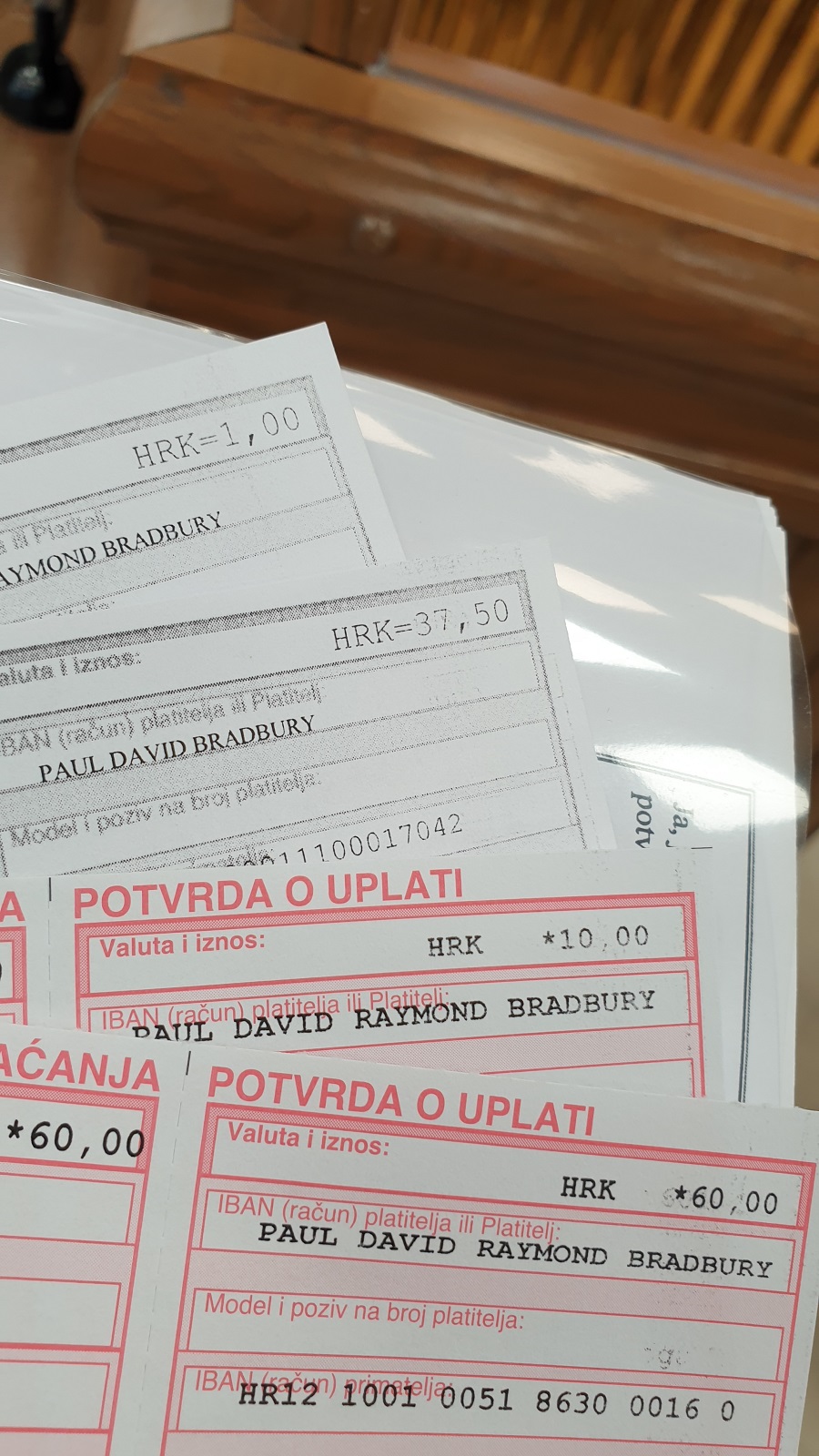
Sometimes, however, I just have to get out there without her help. Dealing with Croatian bureaucracy is always great blogging material, and so it proved last week as I went to open a Croatian company for a new project we have. You can learn more in Croatian Bureaucracy in Action: The Pain Required to Pay 1 Kuna.
This week's bureaucratic challenges looked all the more daunting, and I had allocated what I hoped would just be a morning, but could possibly take all day. Here was my list of tasks on Thursday morning in Varazdin.
1. Visit Bank 1 to finalise a leasing contract for our (not so) new car.
2. Take contract to the public notary to sign and stamp.
3. Return signed contract to Bank 1.
4. Proceed to my heroes at FINA to collect the paperwork for my new company.
5. Visit Bank 2 to open a bank account for my new company.
6. Return to FINA to hand over a document from my new bank account at Bank 2.
7. If I was finished by midday, buy some chicken and veg from the market, asked my wife. Ha, finished by midday - not a chance.
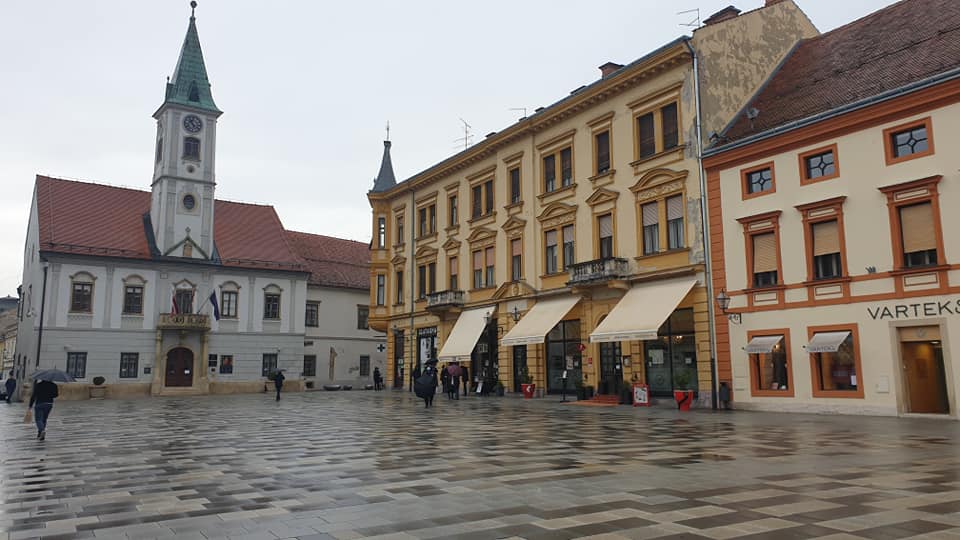
As I criss-crossed the gorgeous old town of Varazdin to my various bureaucratic points of challenge, I felt a little depressed by my normally uplifting surroundings. The bleak weather did not help, but it was the lack of people and cafe tables and chairs.
For we are currently living in the insane world where cafes are closed, but people can buy their drinks and sit on park benches next to the cafes and drink there. In the latest example of the absurdity of life currently in Croatia, cafes were allowed to sell drinks to go from February 15. The fact that they were banned from doing so before, despite places such as bakeries being allowed to, gives an indication of how nuts things are in Croatia at the moment.
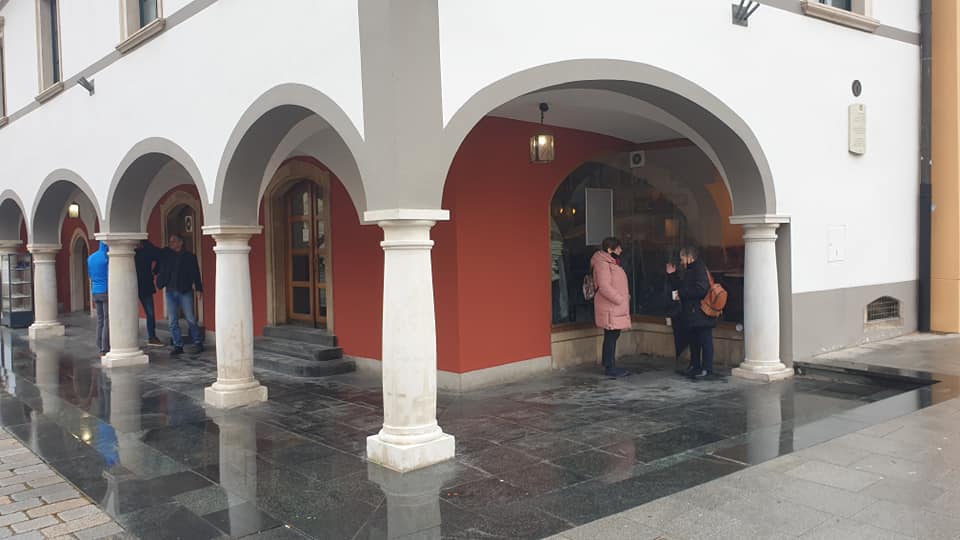
Cafe to go, the reality. A normally popular cafe brimming with life and outside tables and chairs on the main square in Varazdin.
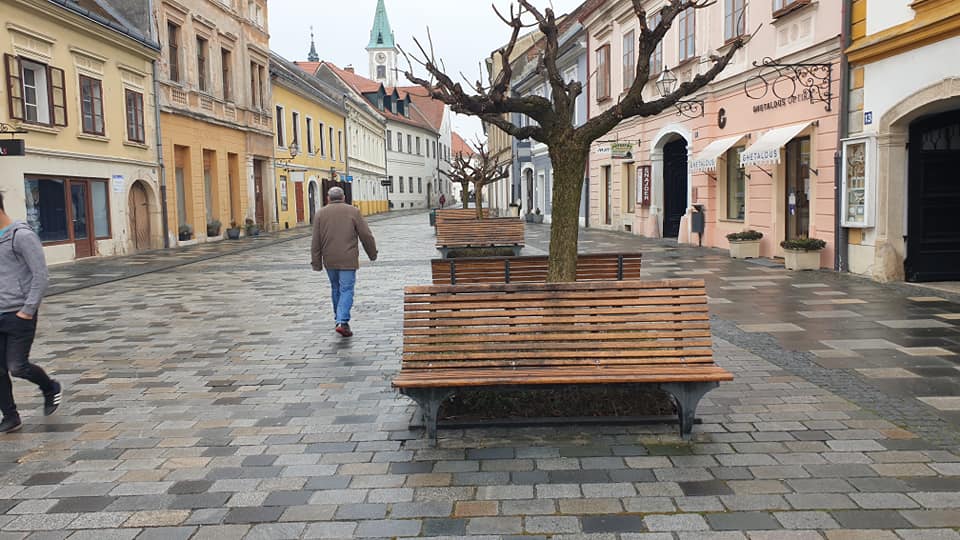
Had the weather been better, there would have been people sitting with their coffee to go here.
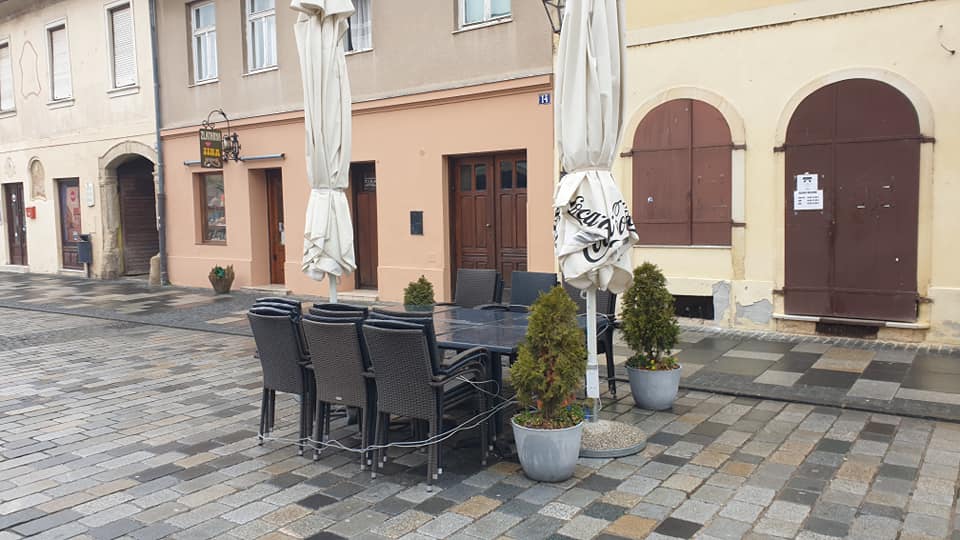
Meanwhile, two metres away...
I digress. Bank 1 was a breeze. The very efficient leasing lady was very organised. All was ready, and she asked me to check the details, presented me with a folder of documents and sent me on my way to the public notary. The notary welcomed me back like a long-lost friend. There was no queue, and all was going superbly until she noticed that the address did not quite match the one on my ID. Here we go...
But this is Varazdin, not Dalmatia. A phone call, an exchange of email addresses, and the revised contract was printed off by the secretary within 5 minutes. Five minutes later, I was on my way.
croatian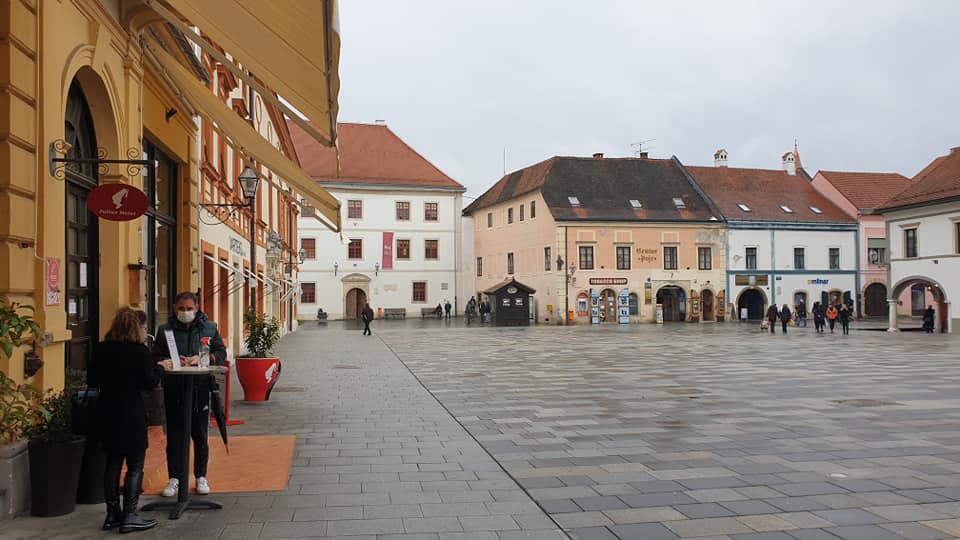
Passing through the gates of Hell into FINA, the very efficient man who processed my application had another neat folder waiting for me. All was ALMOST complete, he assured me. I just had to go and see his colleague and fill out a form, then pop into Bank 2 to open the account and return him a document from Bank 2.
The kolegica looked at me and handed me a form with some rapid-fire instructions. This was the 'make or break' moment for me. If I caved, I would have to figure out how to fill in the form on my own and would probably get it wrong. If she did it, I could be on my way and on course for the market shopping. The prospect of a spicy chicken curry for lunch hung in the balance.
Pressing the form towards me, she clearly wanted me to get out of the way so she could deal with the next person. I employed my most effective defence against such situations when dealing with Croatian bureaucracy. I gave her the 'I am a helpless foreigner who doesn't really understand the language and is crap at filling out forms, but I will stand here and look pathetic until you help me' look.
It worked.
"Give me the form and your ID."
Five minutes later I was on my way, destination Bank 2. Time on the clock - 37 minutes taken so far. I was literally flying. Bank 2 was my bank, I have been with them for 17 years, both my personal and company accounts. This would be over in minutes, the chicken bought, and curry was assured.
"Sorry, you are a foreigner, you cannot open a business account here in Varazdin. You have to do it in our branch in Zagreb."
What?!?
There was no arguing with the lady, rules where rules. My accountant checked with the bank and they have just changed the rules, so the information I was given was correct. I made an appointment with the bank in Zagreb. The next available appointment is on March 3, some 2 weeks away. In a different city.
Croatian banking service in the 21st century.
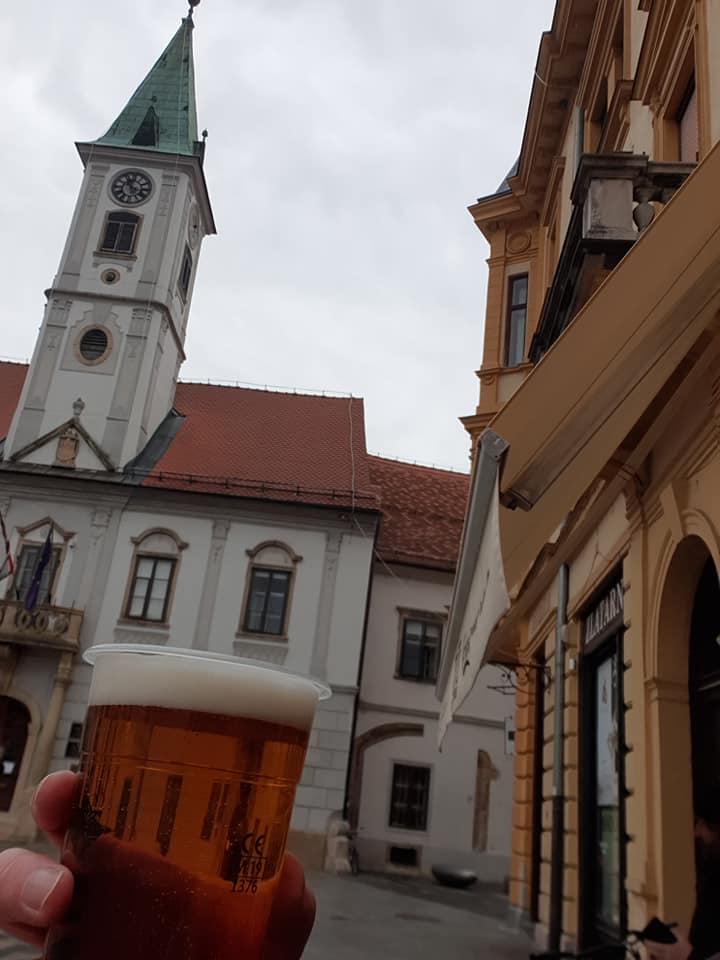
Every cloud has a silver lining. With no account to open and no document to return to FINA, the market chicken and veg were mine, and there was plenty of time to stop for a 'beer to go.' So unaccustomed was I to the realities of cafe life in 2021 in Croatia, the option of stopping off for a cold one did not occur to me.
So there I was, almost alone on the main square, 16 kuna poorer after swapping my cash for a cold one in a plastic glass and just standing there with no tables or chairs around me.
A mildly successful day, all things considered. A little like the chicken and egg conundrum, I wonder what will come first - this foreigner being able to open a bank account or cafes finally opening to end all this madness. To be clear it is the inconsistency that I am referring to when talking about madness. As you can read in our last editorial - As Gym Owner Faces Prison, the Virus Must be Laughing at Croatia's Inconsistent Measures.
International Tourist Guide Day in Croatia: Tours of Skradinski Buk, Varaždin, Garešnica
February 17, 2021 – Although the tourism sector has been hit hard by the coronavirus crisis, the International Tourist Guide Day in Croatia will be marked with occasional tours of Skradinski Buk in Krka National Park, Varaždin city, and Garešnica in northern Moslavina.
Since 1990, the International Tourist Guide Day is celebrated on February 21, when the World Federation of Tourist Guide Associations declared it. This year, their theme is "Tourist guides – contributors to rural tourism through creative storytelling." Some Croatian destinations decided to mark it offering walking and storytelling tours.
Krka National Park
In business and life in general, one should always be accommodating and kind. Such are the guides in Krka National Park. These enthusiastic and creative guides seek to teach visitors about the area's natural and cultural values through direct experience.
Krka National Park invites all nature lovers to join them in a guided tour of Skradinski Buk on Saturday, February 20, 2021. While enjoying the winter atmosphere, visitors will get acquainted with the exceptional flora and fauna, rich cultural and historical heritage, and traditional crafts in the ethno-village.
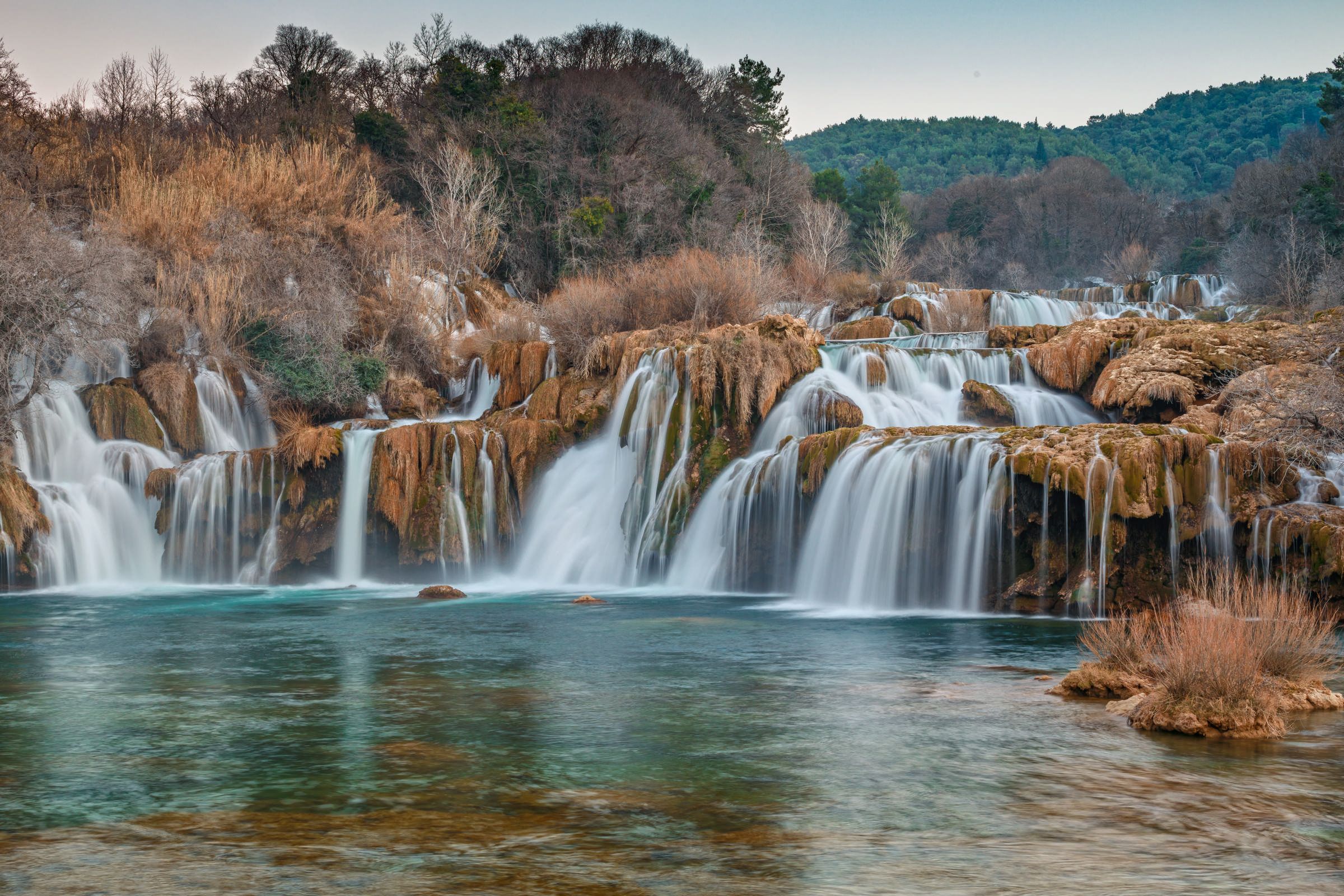
Skradinski Buk in Krka National Park / Copyright Romulić and Stojčić
The number of participants per group is limited, and you can book your visit via the following link. In the winter months, ticket prices for Krka National Park are 30 kunas for adults and 20 kunas for 7 to 18 years old children. The Park is open from 9 a.m. to 4 p.m.
For Krka's guides, interpretation is not just a "job," but a way of exchanging values, emotions, and inspirations. It is successful when the visitor saw, experienced, and began to appreciate something in the protected area unknown to them before.
Varaždin
For the eleventh year in a row, the International Tourist Guide Day will be marked in Varaždin. On Sunday, Varaždin tourist guides will take citizens and their guests free of charge through the historic city center and introduce them to interesting facts from the history and present of Varaždin.
The starting point for tours of the historic city center will be in front of the City Hall, and the tours will start at 10.30 a.m. and 11.30 a.m., following epidemiological measures.
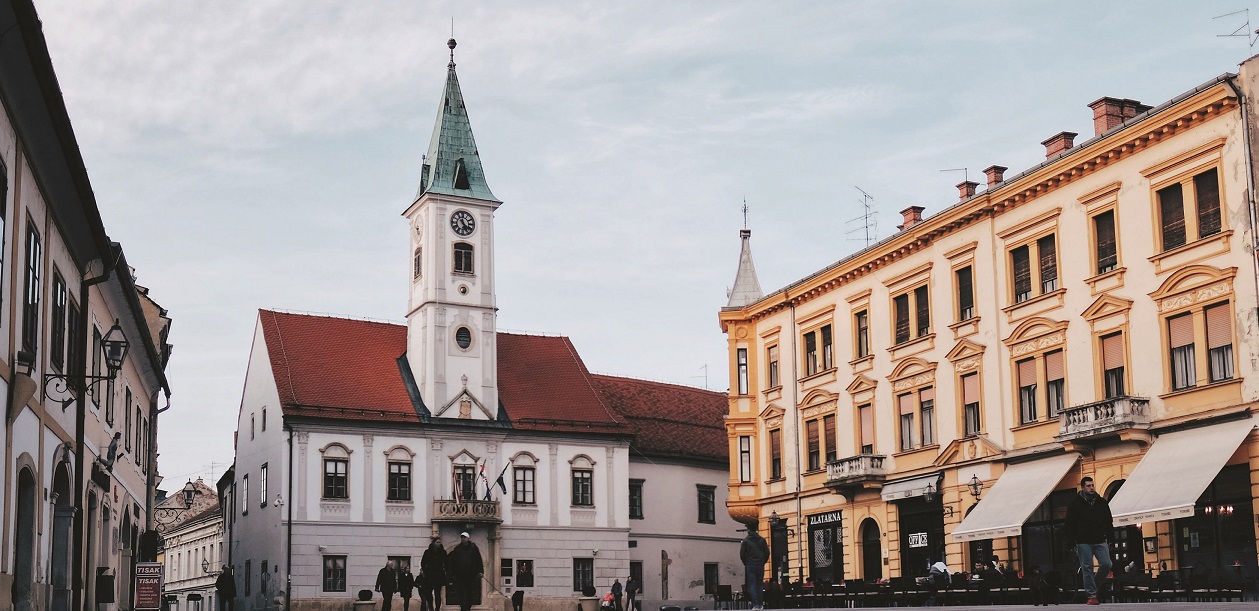
The city of Varaždin / Photo: Varaždin Tourist Board
Besides numerous facts, stories, and legends, visitors will learn some interesting things related to health – the tradition of hospitals in Varaždin, doctors in the past, where the first pharmacy was, and where public bathing areas were.
Garešnica trails of north Moslavina region
In Garešnica, the hometown of two world-famous personalities, "Mr. Morgen" Ivo Robić and Apollo engineer Mike Vucelić, the International Tourist Guide Day will be marked with free walking tours of northern Moslavina. A natural border, the Ilova River, separates Moslavina from neighboring Slavonia.
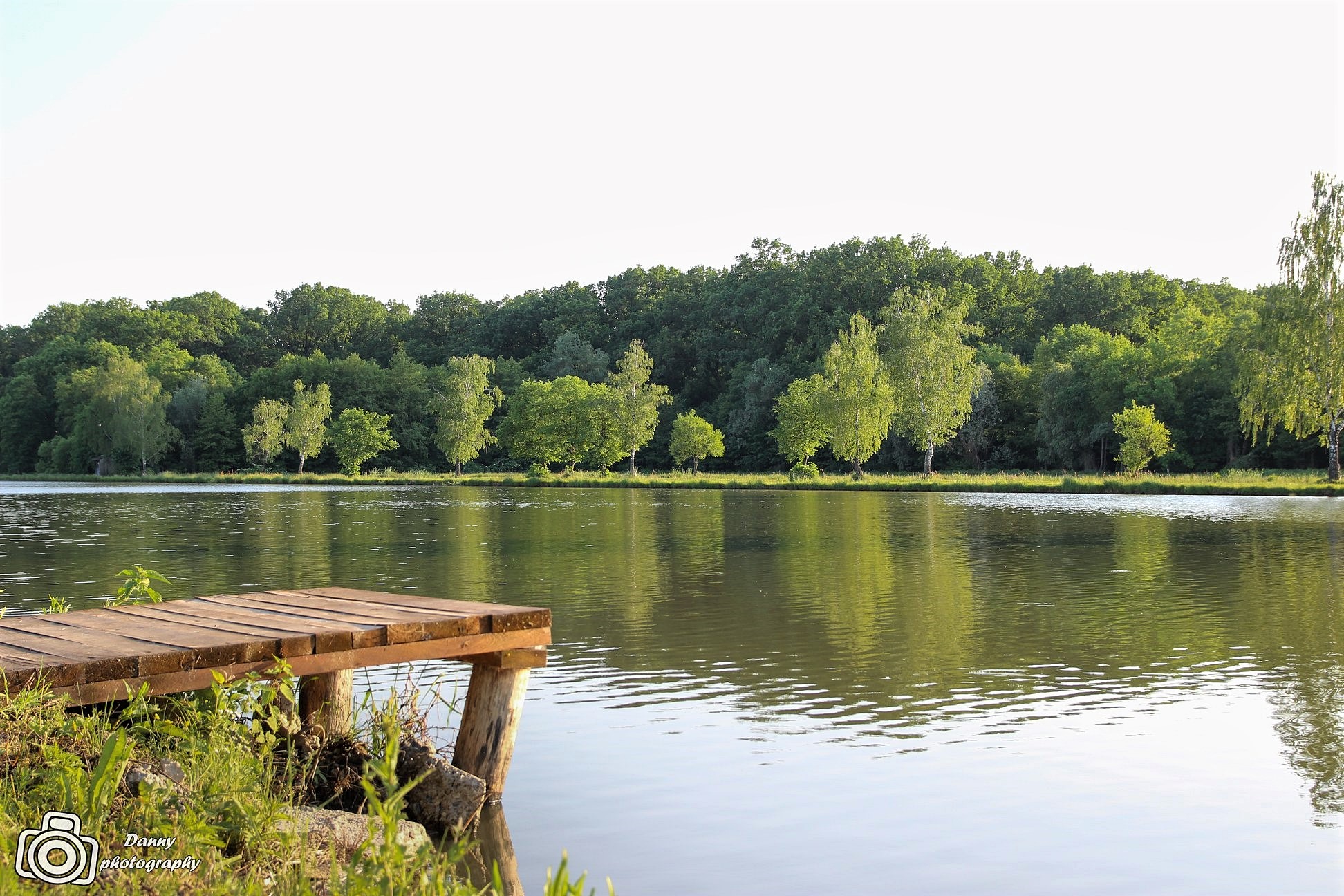
Photo: Northern Moslavina Tourist Board
During the six-kilometer walk, visitors will get to know the peculiarities of Garešnica and northern Moslavina: the old railway (where it led, how it connected Garešnica, when it ceased to serve its purpose), Equestrian Club Garić, Selište, Lake Skresovi (fishing tradition of Moslavina).
On Saturday, February 20, the tour will begin at 5 p.m, and on Sunday, February 21, at 9:30 p.m. on the Garešnica town square.
For the latest travel info, bookmark our main travel info article, which is updated daily.
Read the Croatian Travel Update in your language - now available in 24 languages.
Varazdin Cabbage Queen on Most Innovative Woman in EU Agriculture Shortlist
February 12, 2021 – Marija Cafuk, who successfully lead the campaign to have Varazdin cabbage protected by the EU, has been shortlisted for the award of Most Innovative Woman in European Agriculture. She used the opportunity to voice her concerns for Croatia's small producers under proposed new changes in the laws on seeds
Inexpensive and packed with nutrients and vitamins C + K, the humble cabbage is a staple part of the Croatian diet. One of its most famous varieties is Varazdin cabbage (Varaždinsko zelje), which is protected at a European level as distinct in coming from its point of origin.
Varazdin cabbage's successful entry into European protection is in no way thanks to the efforts of Varazdin resident Marija Cafuk, who is the custodian of Varazdin cabbage seeds and the only person in Croatia who is licensed to sell them. For her efforts, she has now been shortlisted by the European Association of Agricultural Producers Copa Cogeca for the award of Most Innovative Woman in European agriculture.
According to Copa Cogeca, the award aims to highlight the contribution that women make to rural development and the development of new models of food production in the context of climate change and environmental protection.
“Of course, I was pleasantly surprised by the nomination, which I think is a recognition of the long struggle to preserve our Varazdin cabbage seeds in conditions when we lost the last companies that were engaged in seed production and (had to) depend on imports,” Mrs. Cafuk told journalist Zlatko Simic in a recent interview with Jutarnji List. “You know how many conditions we had to meet in order for our seeds to be on the variety list! Let the EU see that there are people in our country who want to preserve their indigenous varieties for future generations.”
The latter part of her comment to the journalist refers to the proposed changes in seed registration laws that are looming on the horizon at both a national and an EU level. Small producers and family farms in Croatia are concerned about the loss of traditional seed varieties and their abilities to grow from them under the conditions of the changes in legislation.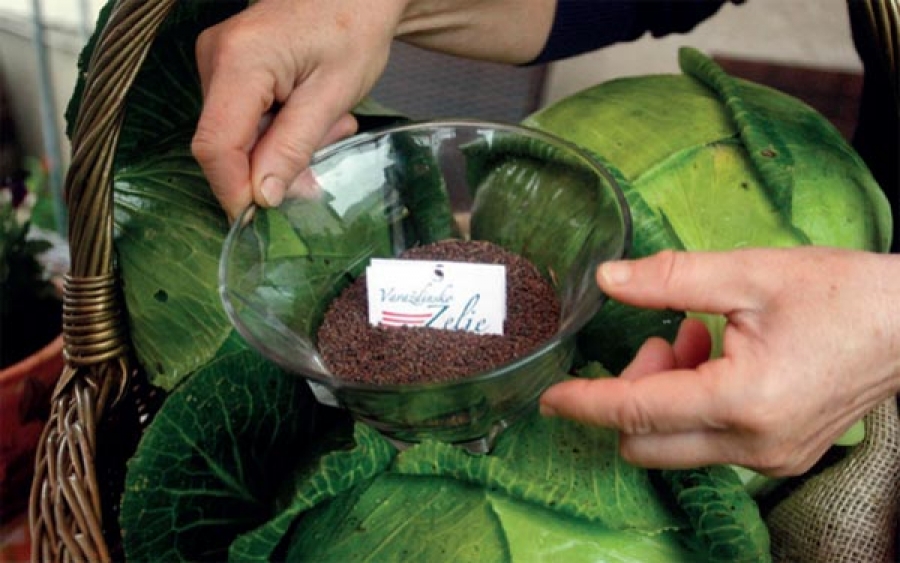 Varazdin cabbage (Varaždinsko zelje) and its seeds © Varazdin County Tourist Board
Varazdin cabbage (Varaždinsko zelje) and its seeds © Varazdin County Tourist Board
“The problem is not only in paying the large costs we have in controlling the sowing of our certified seeds,” Mrs. Cafuk told the journalist, expanding on the matter of the changing seed laws, “but also in increasing the costs we may have if we had to deliver all the seeds we produce for processing, as (will be) required by law.”
Mrs. Cafuk told the journalist she hopes that the ongoing and popular protests and petitions of associations that keep domestic seeds will lead to a positive outcome in regards to the proposed national changes. Of course, she was speaking on behalf of seed custodians and small producers all over Croatia. Having attained its European protection already, Varazdin cabbage and Mrs Cafuk's enterprises are already safe.
Varazdin cabbage is one of two kinds of Croatian cabbage protected by the EU
There are in fact two types of Croatian cabbage protected at the European level – Varazdin cabbage and cabbage from Ogulin. But, whereas Varazdin cabbage is protected in its raw, unprocessed form, the cabbage from Ogulin is protected as a product after its fermentation (it is made into what is sometimes called sauerkraut).
In 2015, when the application was made to European authorities to protect Varazdin cabbage, a notice of opposition was lodged from nearby Slovenia. Slovenia had added new cabbage varieties to its national variety register in 2012 under the names ‘Varazdinsko 2’ and ‘Varazdinsko 3'. Varazdin is a centuries-old town in northern Croatia.
The notice of opposition was discounted. The EU office responsible for protecting new varieties did not consider Varazdinsko 2 and Varazdinsko 3 to be appropriate names, as they suggested a link to a geographical area with which they had no direct connection and to that extent were confusing to consumers. With this impasse of international cabbage recognition finally overcome, Varazdin cabbage was granted its European protection.
PHOTOS: Outstanding Contemporary Croatian Architecture of the Year
February 10, 2021 – 10 of the most outstanding examples of contemporary Croatian architecture have been selected by the Association of Croatian Architects to compete in the extremely prestigious Mies van der Rohe Awards. Held only once every two years, they are the European equivalent of the Pritzker Prize for Architecture.
The Mies van der Rohe Awards are a really big deal. The greatest works of European architecture compete for recognition in the competition. The greatest success of Croatian architecture in the awards was attained by UP studios' Toma Plejić and Lea Pelivan, who received a special award for upcoming architects and had their high school in Koprivnica named the best building in that category in 2009. The success has had a considerable impact on their careers since.
Being held only once every two years, Croatian architecture projects completed since the closure of entries for the 2019 awards are eligible to be submitted. Here are the outstanding examples of contemporary Croatian architecture that will represent the country in 2022.
Cinema Urania Zagreb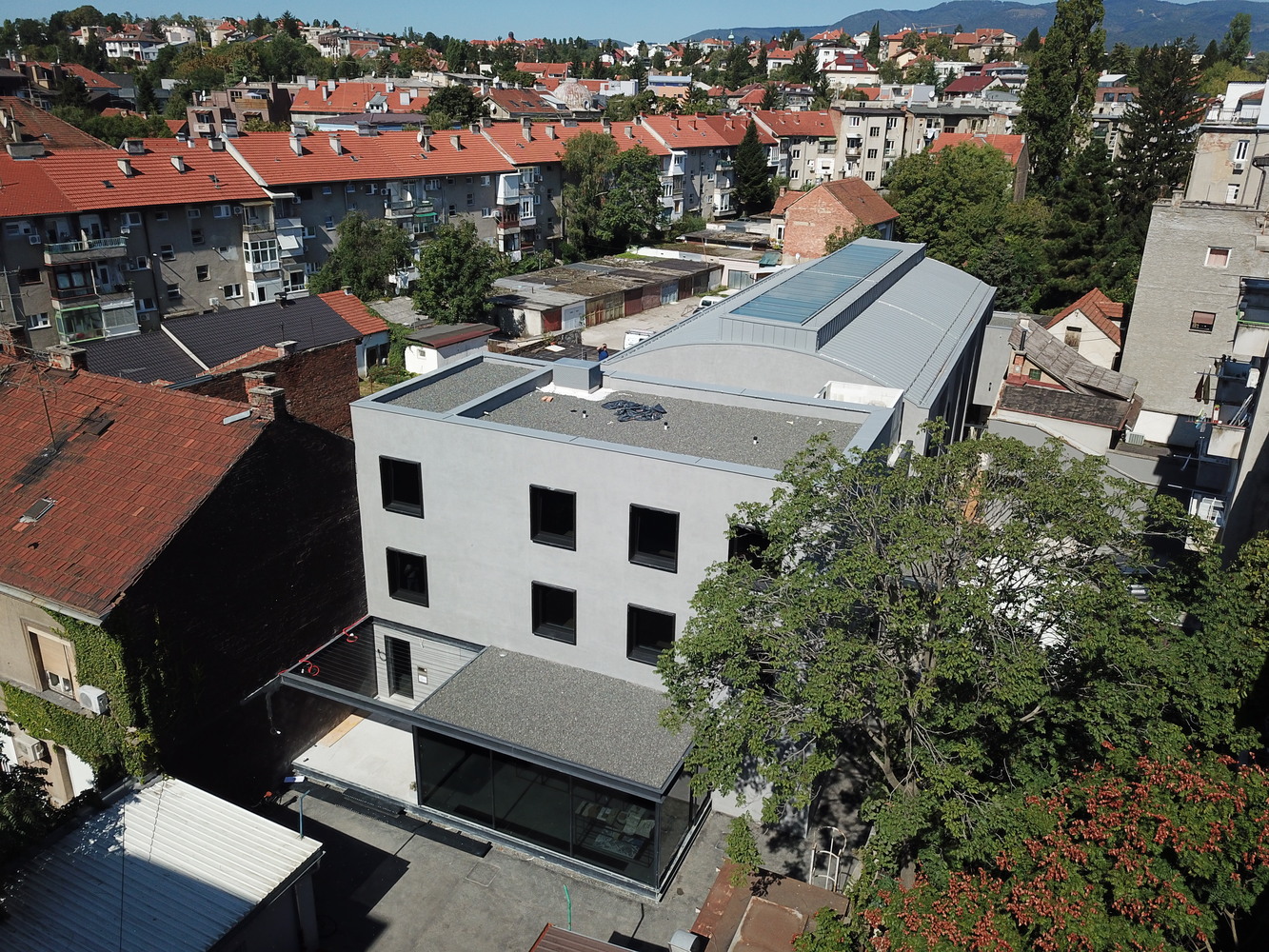
An old neighbourhood cinema built into the back streets near Kvatric. In their redesign, 3LHD preserved the best features from this early example of concrete engineering in Croatian architecture. They added a glass pavilion at the entrance, atriums and skylights, flooding the former darkness with the natural light needed for its new purpose as an event and work space.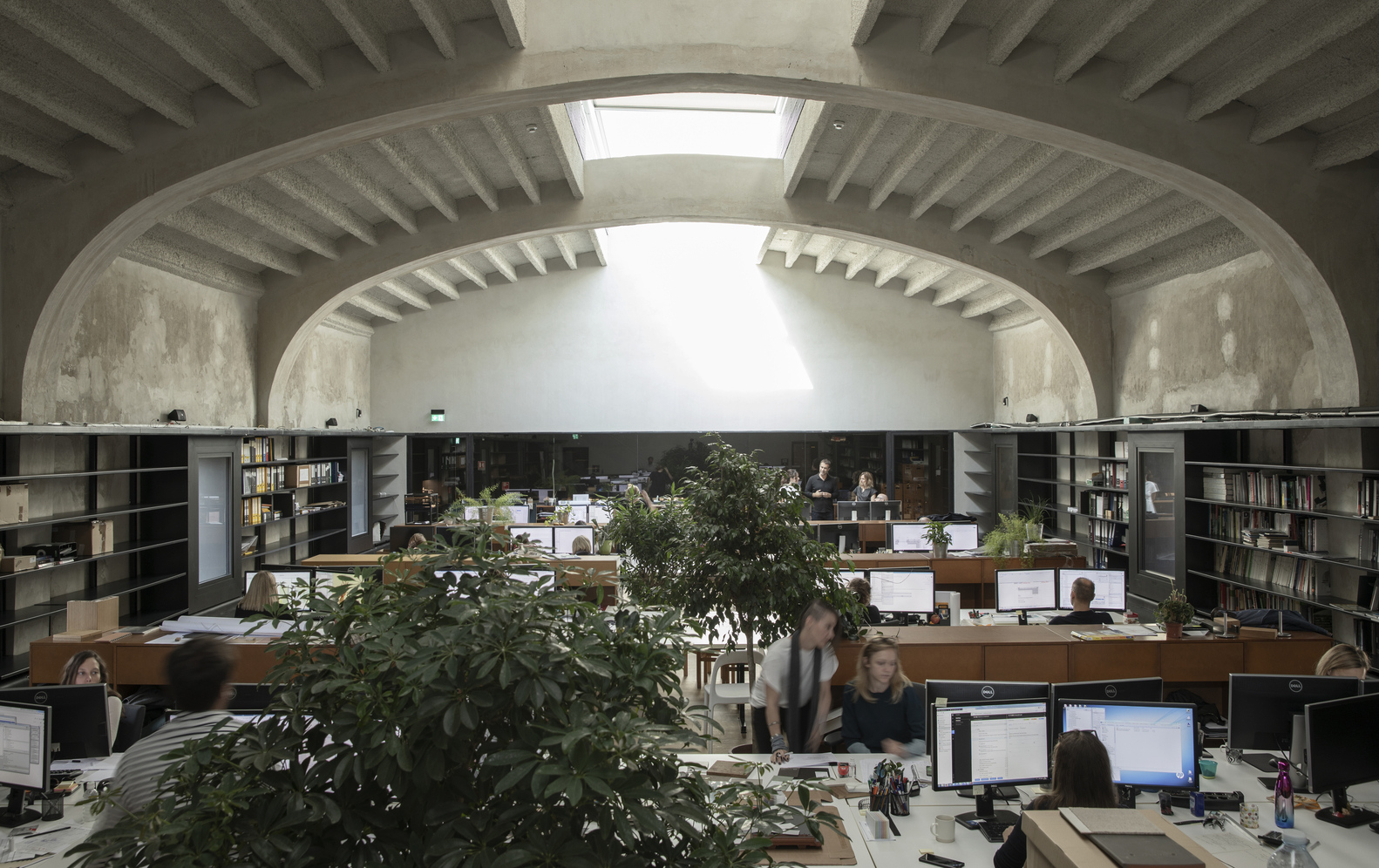 © Jure Živković
© Jure Živković
Grand Park Hotel, Rovinj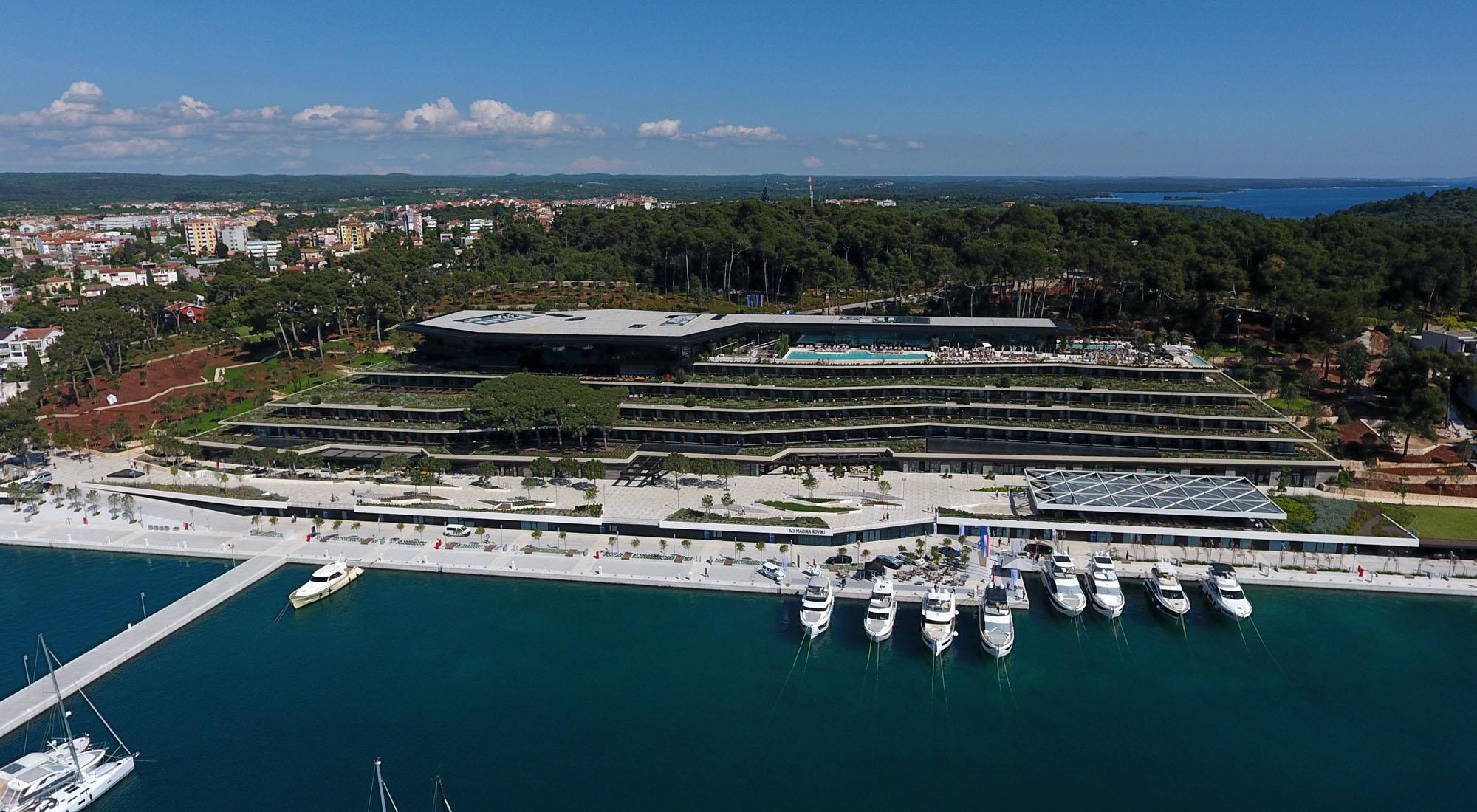
Sprawling widely across six stepped levels, the new luxury Grand Park Hotel and spa could easily have looked a long swipe of concrete. But, by places greenery on each of its staged roofs, architects 3LHD have ensured that no matter where you are in the 500-guest-capacity building, your view places you within a garden, looking out onto Rovinj Old Town and the expanse of the Adriatic. Croatian architecture at its most breathtaking.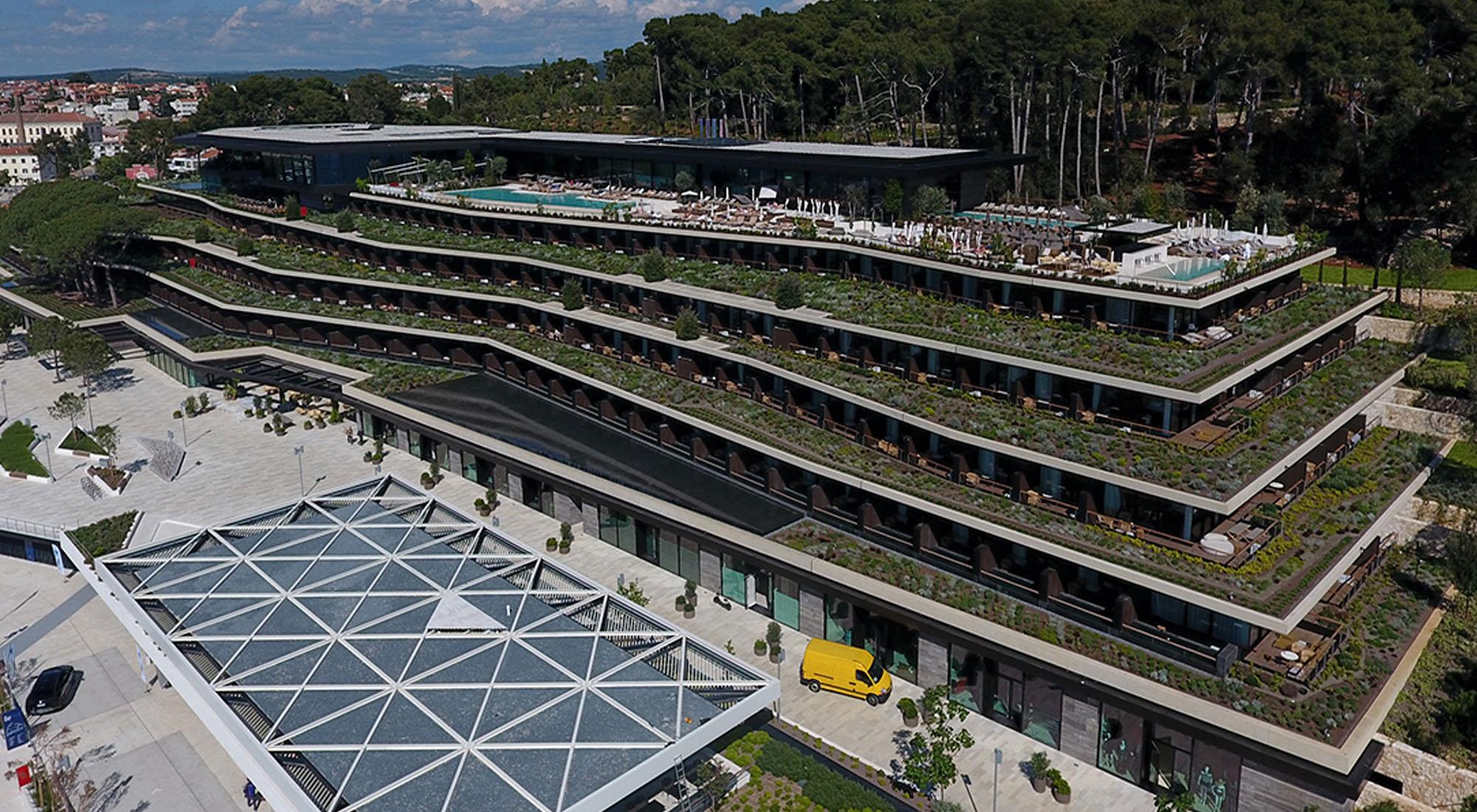 © Alukoenigstahl hr
© Alukoenigstahl hr
Ivanja Reka Elementary School, south Sesvete, east Zagreb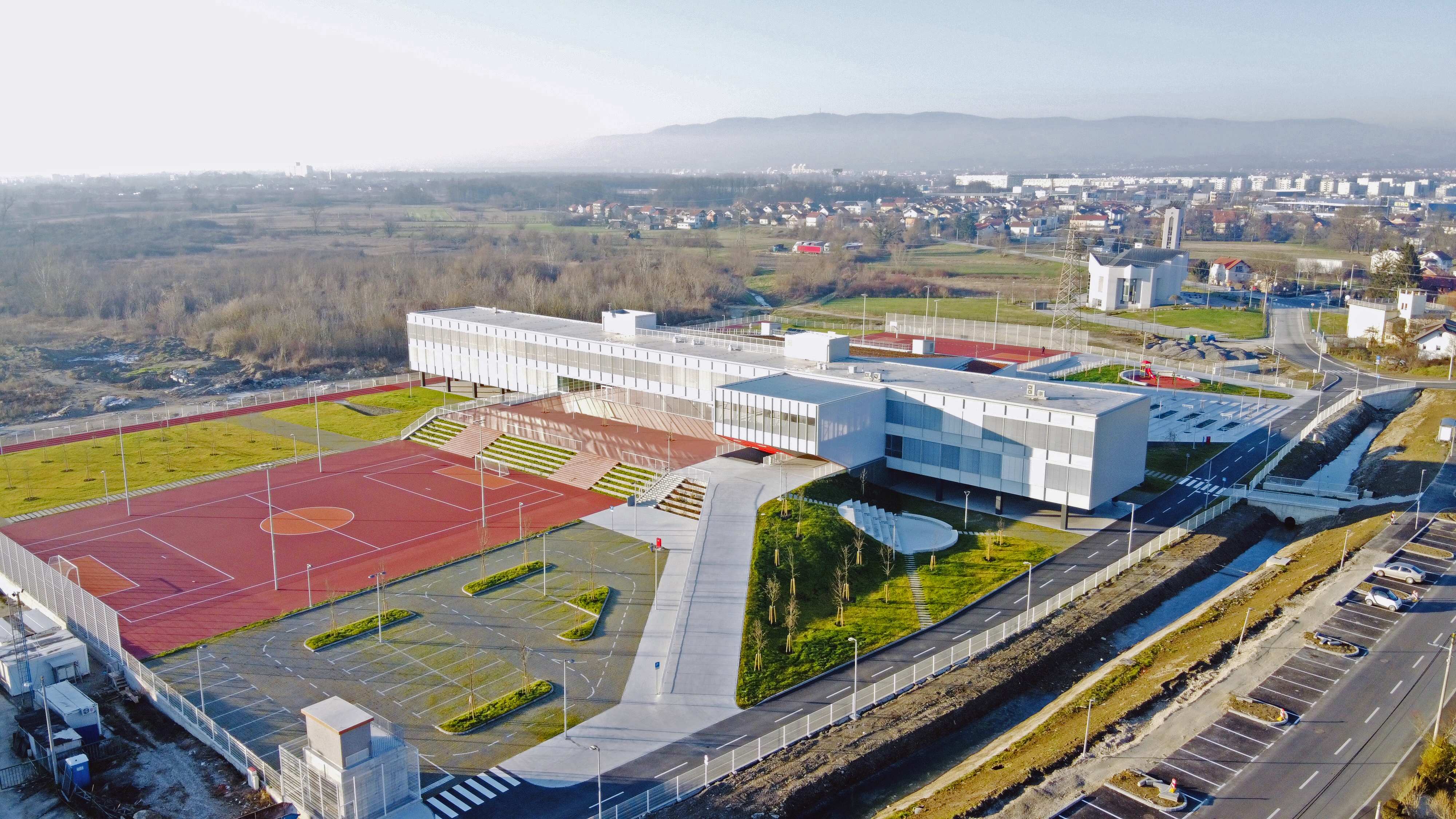
If every elementary school looked as pretty and was as well equipped as Ivanja Reka Elementary School in the south of Sesvete, eastern Zagreb, you could well believe daily attendance would never drop below 100%. Designed by a team of architectural authors (SUBMAP studios Marija Burmas and Ivo-Lola Petrić, and Jakša Kalajžić from JKA Arhitekti), the multi-level main building sits centrally, surrounded by sports, recreation and other facilities creating an impressive view for both those outside and within.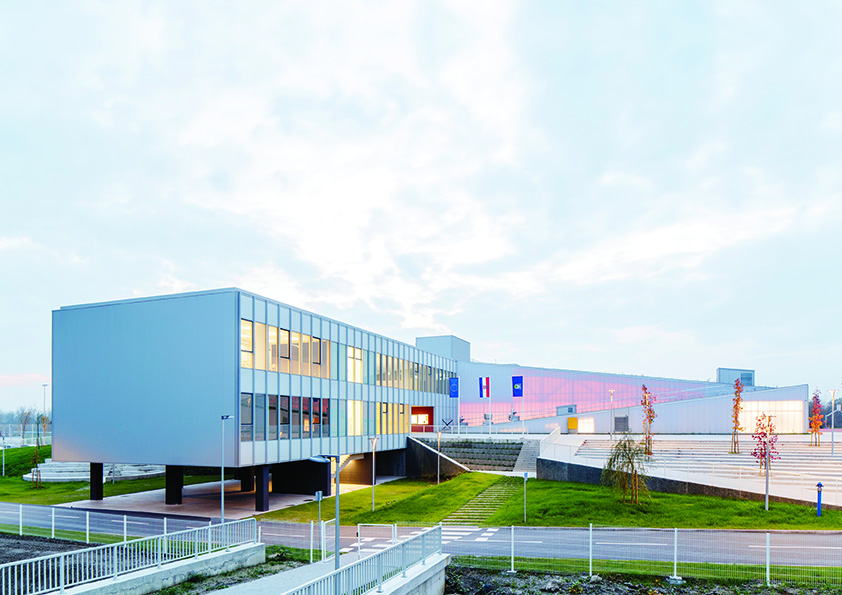 © Ivanja Reka Elementary School / Domagoj Blažević
© Ivanja Reka Elementary School / Domagoj Blažević
Roxanich Wine & Heritage Hotel, Motovun, Istria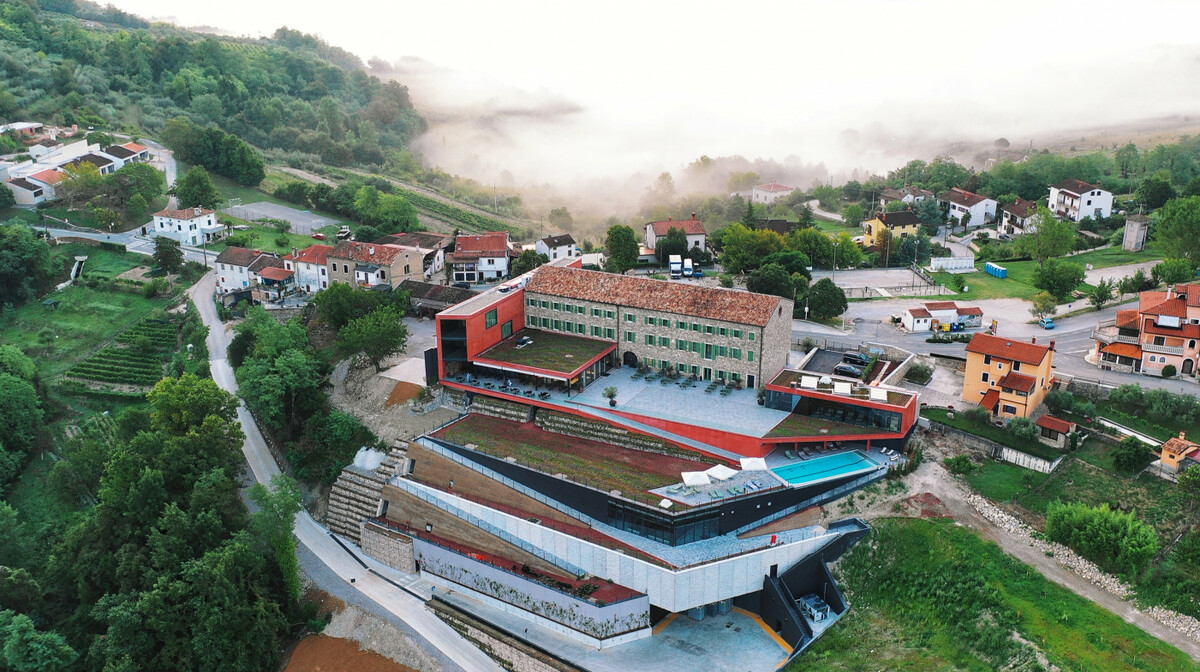
The view is unmistakably Istria. Vineyards carpet the land below and - rising above - the picturesque hilltop town of Motovun. Helmed architecturally by consistently bold Rijeka designer Idis Turato, this multi-level, multi-purpose redesign retains the traditional feel of its existing stone building and its purpose – there's a huge wine cellar beneath – but has opened up the space to give stunning views, not least over a sun deck that spectacularly reflects the sunrise and sunset. This is an active winery, with works and equipment all housed within its lower floors, not that you could tell from the 25 person capacity boutique hotel, restaurant and wine shop upstairs.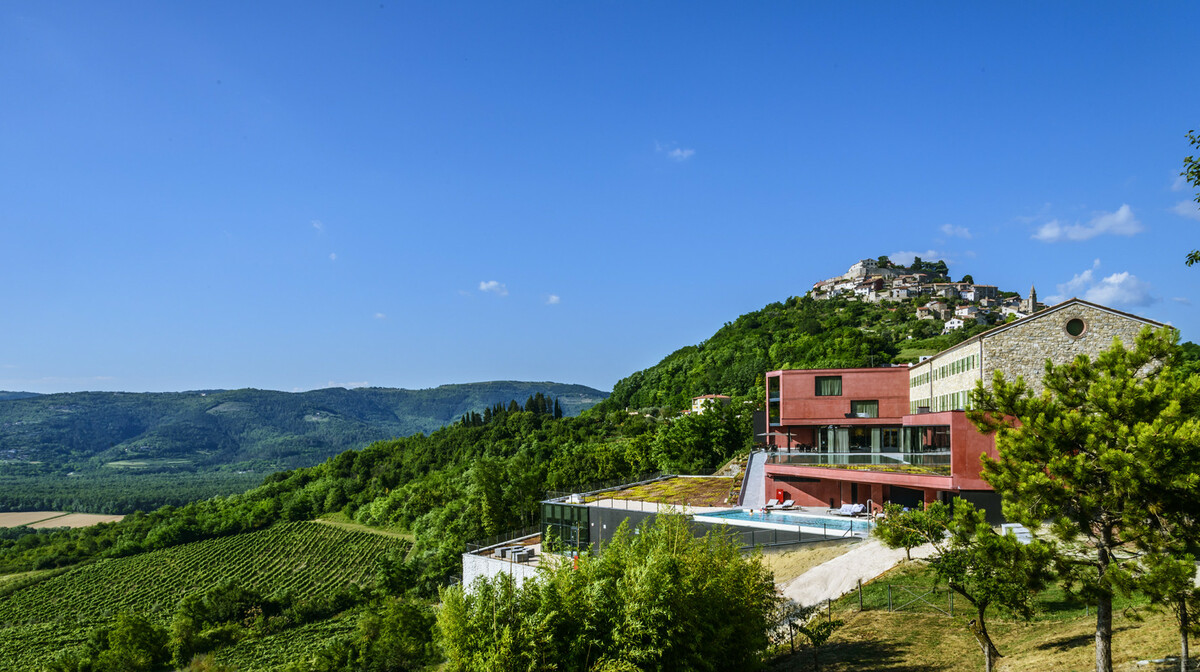 © Roxanich.hr
© Roxanich.hr
Four Houses for Four Brothers, Diklo, Zadar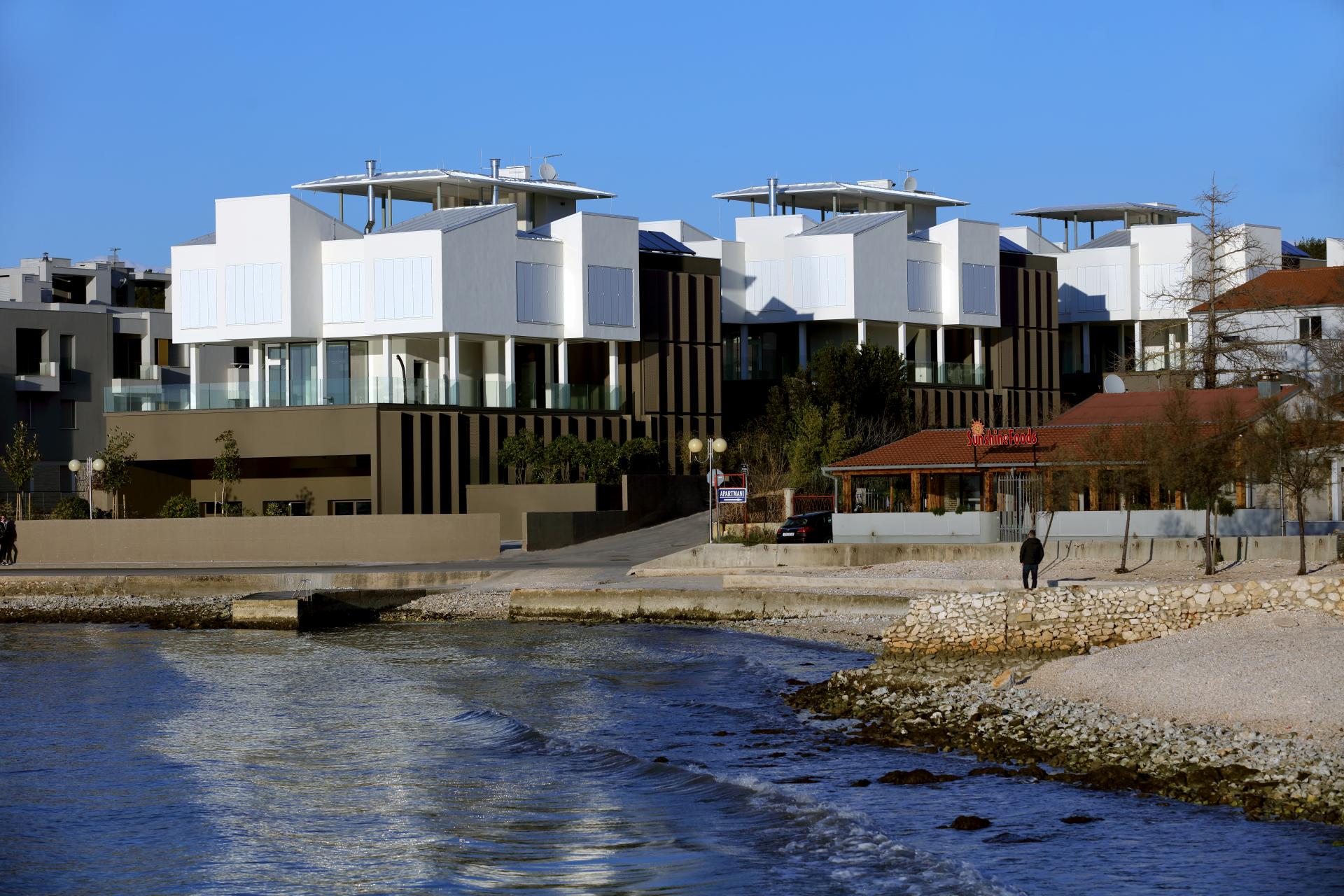
Judging from a theme of project titles used by architects Iva Letilović and Igor Pedišić, we're not sure that Four Houses for Four Brothers was actually commissioned by four brothers or that four live there. But, you could well believe they could. The ultra-modern set of independent houses, located next to a beautiful stretch of coast in a north Zadar neighbourhood, was specifically designed to address a distinctly Croatian reality – how to open up some of your dwelling to seasonal guests while you remain at home. The design separates the buildings clearly into separate quarters which allow privacy, comfort and minimal encroachment for both visitors and residents.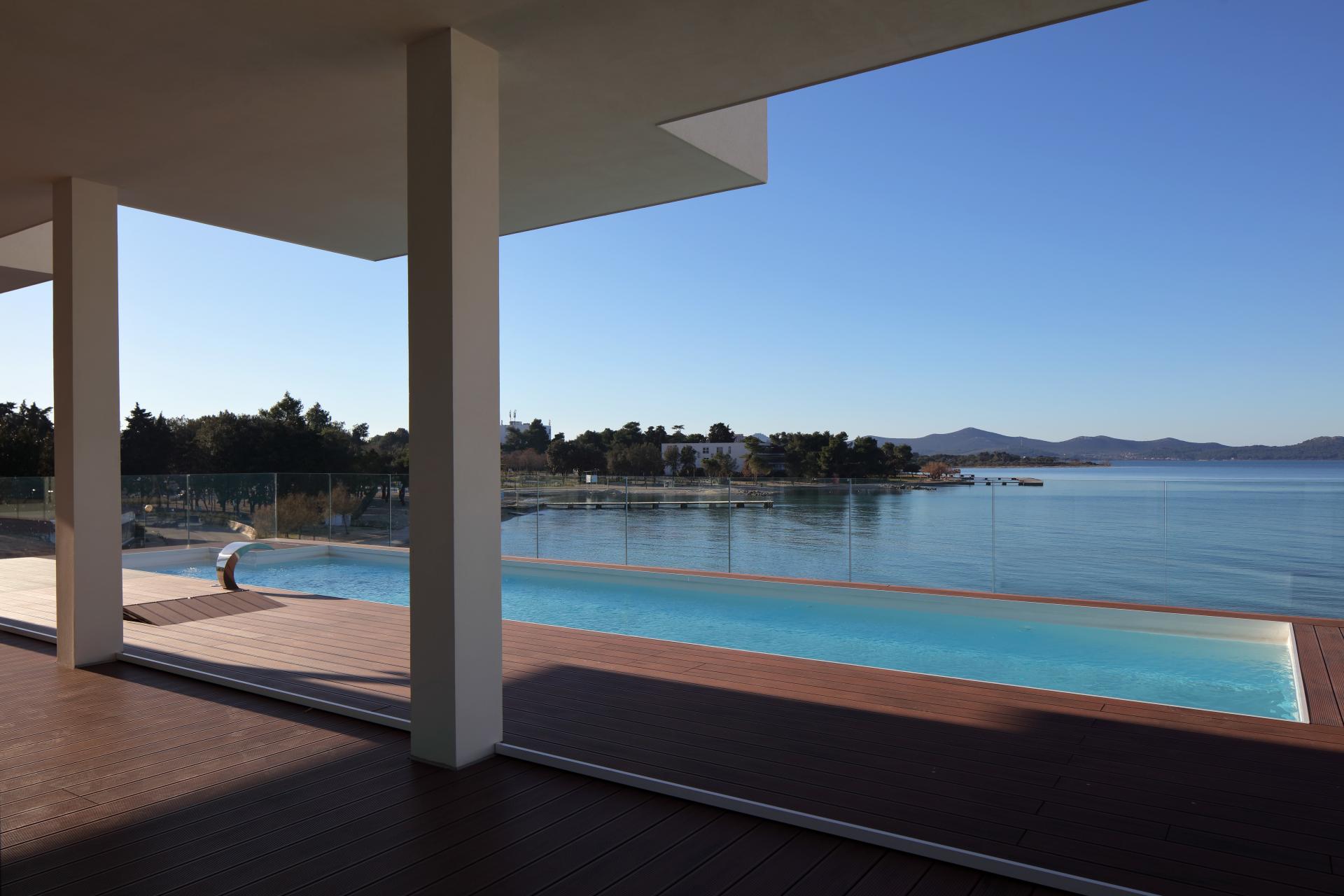 © Igor Pedišić
© Igor Pedišić
Galić Winery, Kutjevo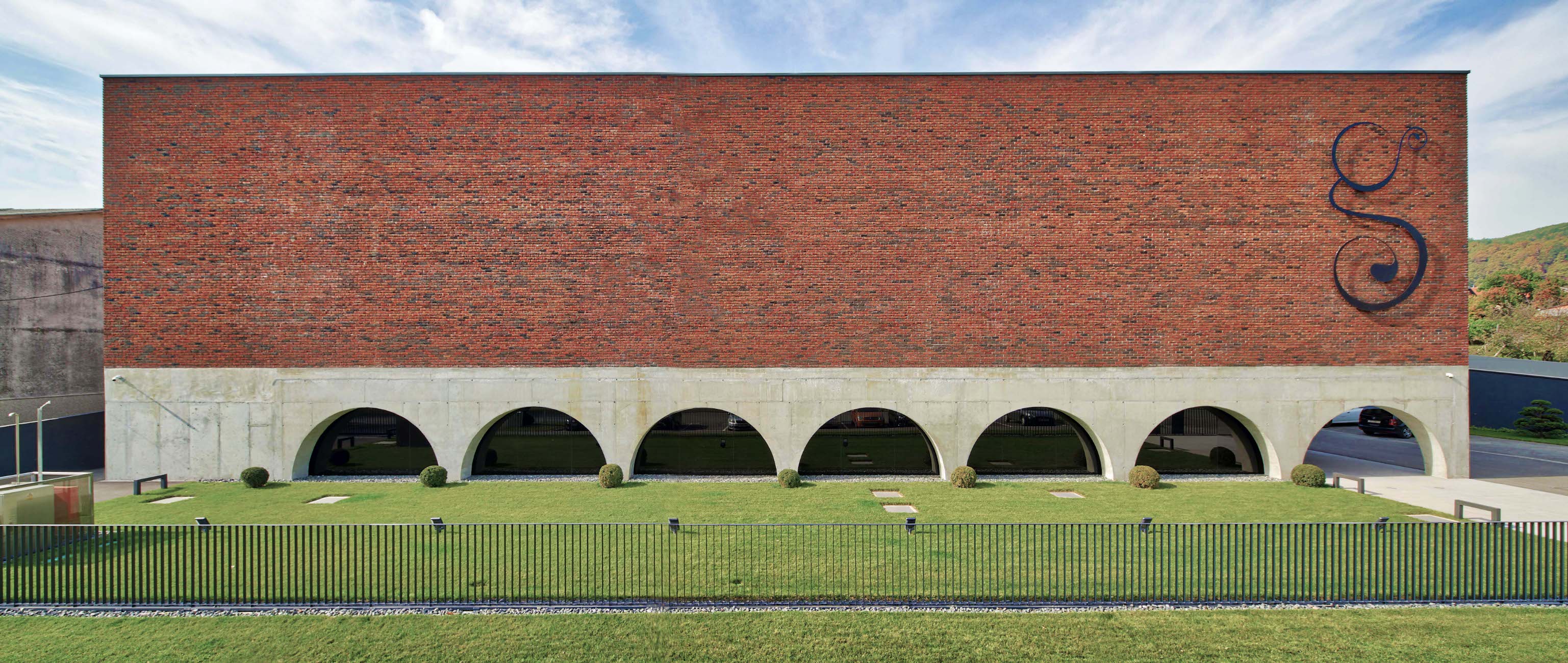
Award-winning outfit Zagreb-based studio Dva arhitekta have an existing, jaw-dropping design for a rural winery commissioned by famous makers Galic. However, that project, as yet, remains unrealised. But, their winery for Galic in the centre of Kutjevo town is complete. Melding the traditional and the contemporary, the upper section of the building is a bold and unblemished red brick, adorned with the winemaker's unmistakable logo. Beneath, concrete arches invite your eyes into the actual wine cellar – neat rows of barrels, protected behind glass walls that are set back from the facade. Brilliant!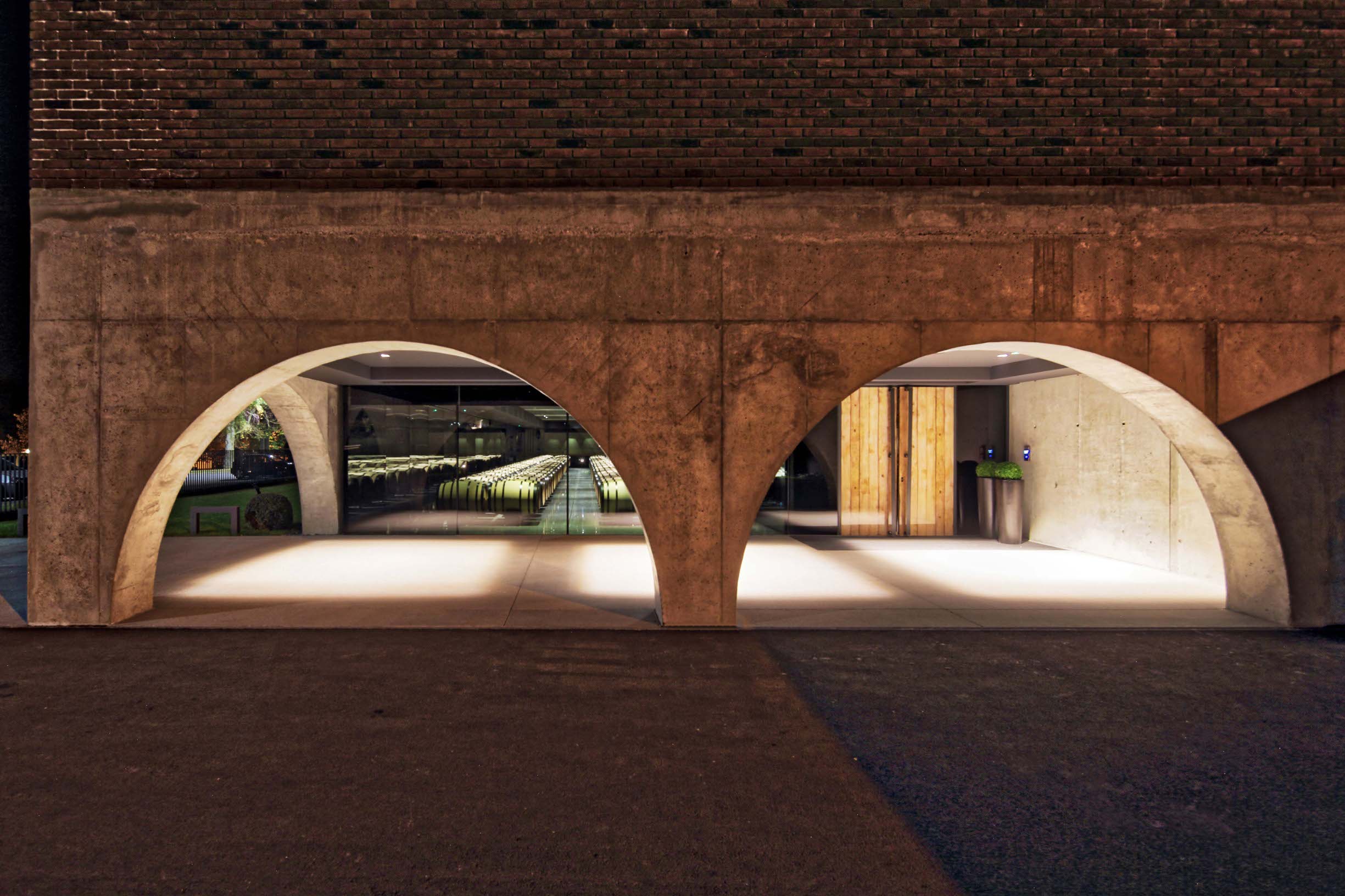 © Damir Fabijanić
© Damir Fabijanić
Seecel Centre, Zagreb
Designed as a regional centre for the development of entrepreneurs and its construction costs generously part-funded by European money, the Seecel Centre arrived long overdue and does not house its intended inhabitants. Such matters are best left for different articles as, here, we're concerned with the undeniable finery of this building's architecture and appearance. Holding space for accommodation, offices, communal collaboration, education and presentations, the five-floored building uses ultra-modern building materials and construction methods to make it low-energy, its great blocks of covered concrete, with glass windows set further back, echoing old fortifications. It was designed by Igor Franić who, in Croatia, is perhaps best known for the Museum of Contemporary Art in Zagreb and completed by him and his team at SZA / Studio za arhitekturu d.o.o.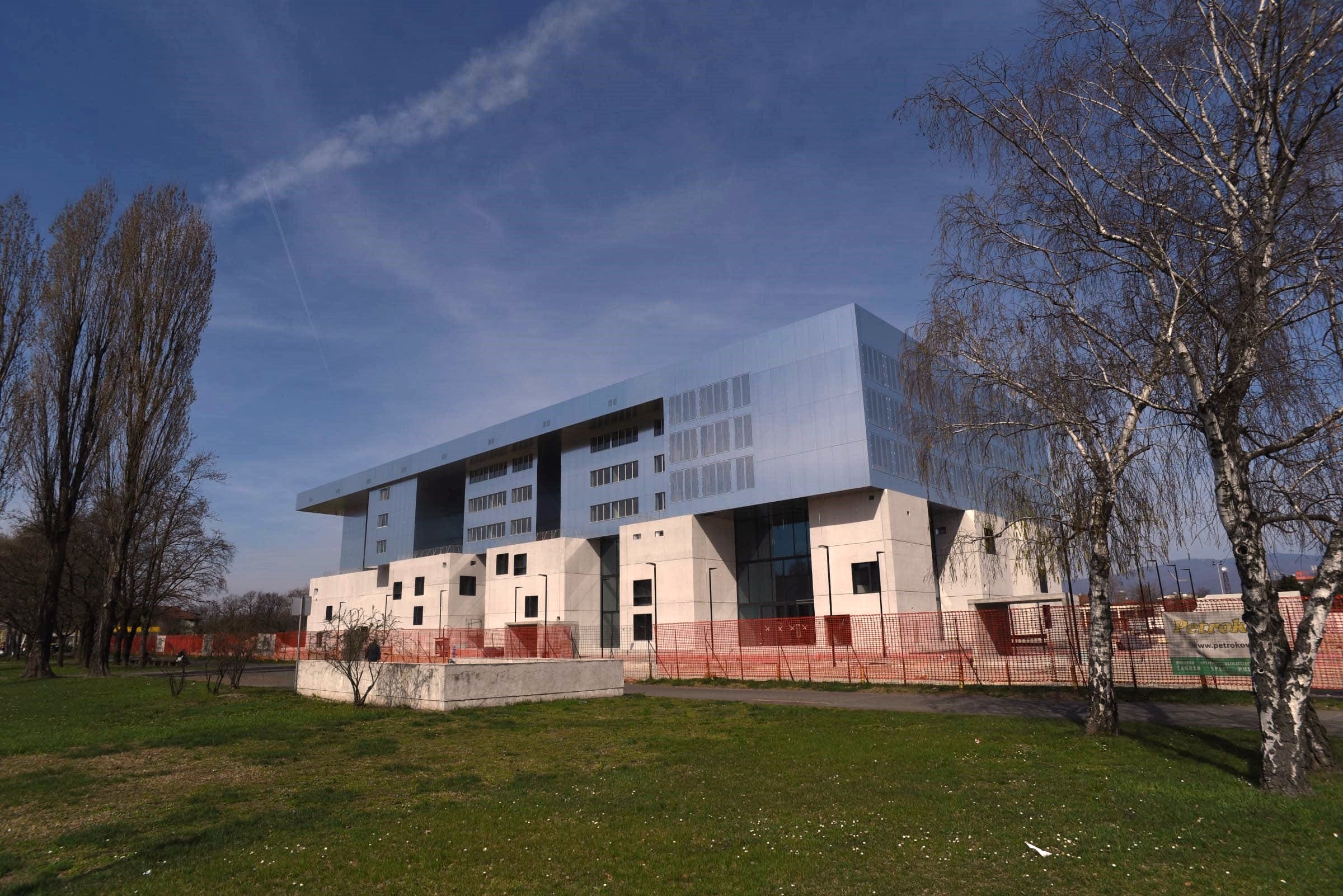 © Site Project d.o.o.
© Site Project d.o.o.
Trg Poljana, Šibenik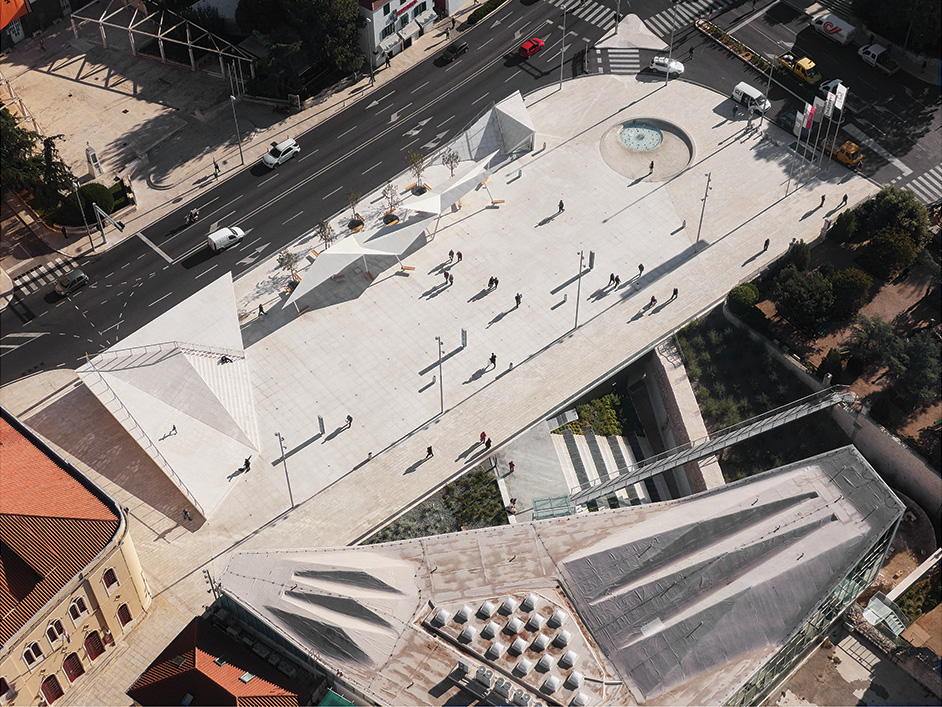
Not a small amount was asked of project architects Atelier Minerva from Dubrovnik in the task to create Trg Poljana in Šibenik. The site had long been earmarked for a much-needed, official town square – a place for events and public gatherings. But, the town was also woefully short on parking. By burying a multi-level car park beneath the open space, the architects successfully met both demands. Triangular shapes sit at an angle above shaded seating, echoing the inclines on the roof of the Juraj Šižgorić City Library opposite. Clever.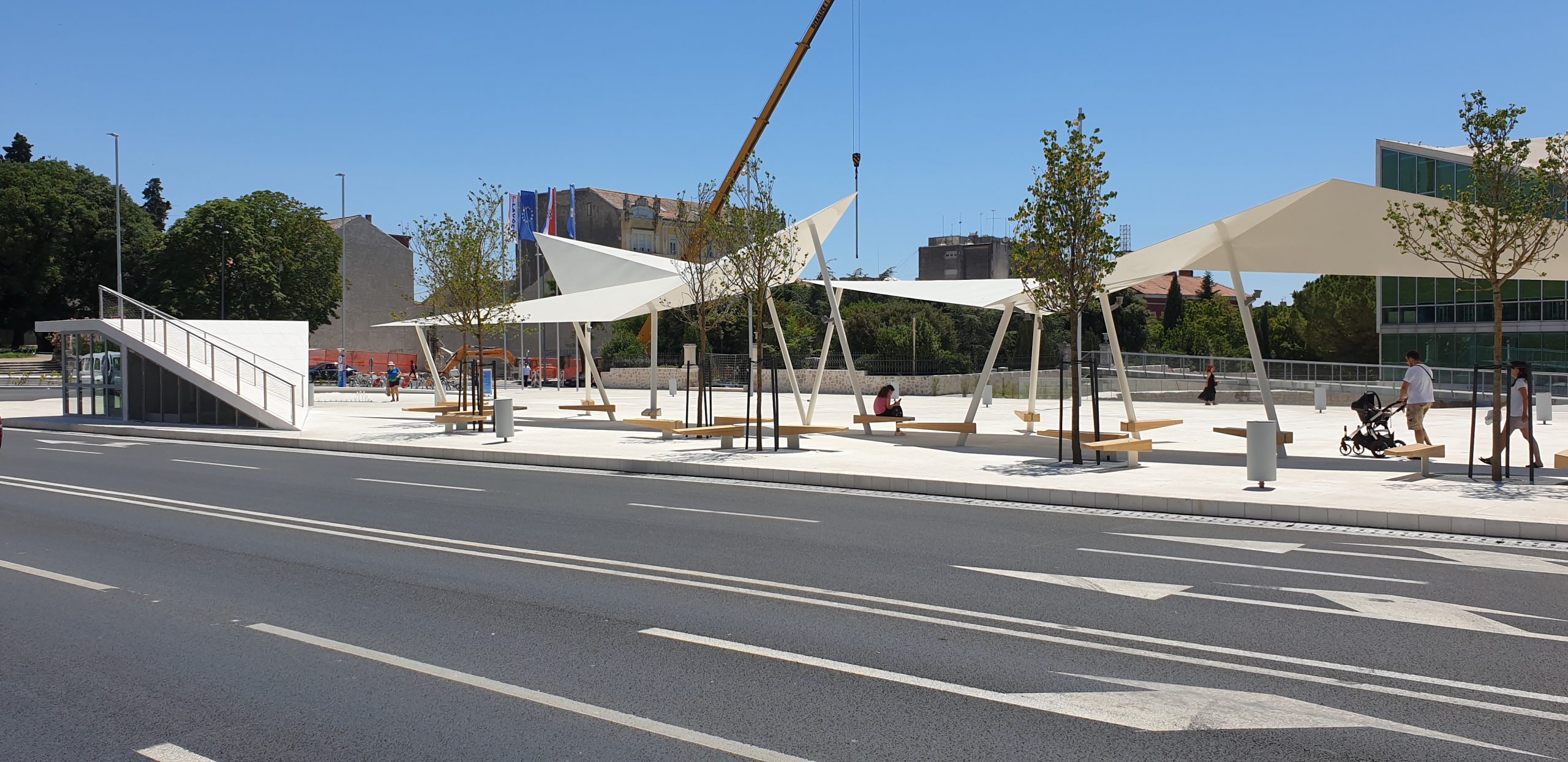 © Ervin Husedžinović / Eccos-inzenjering
© Ervin Husedžinović / Eccos-inzenjering
Homestead on Hartovski vrh, Žumberak, Zagreb County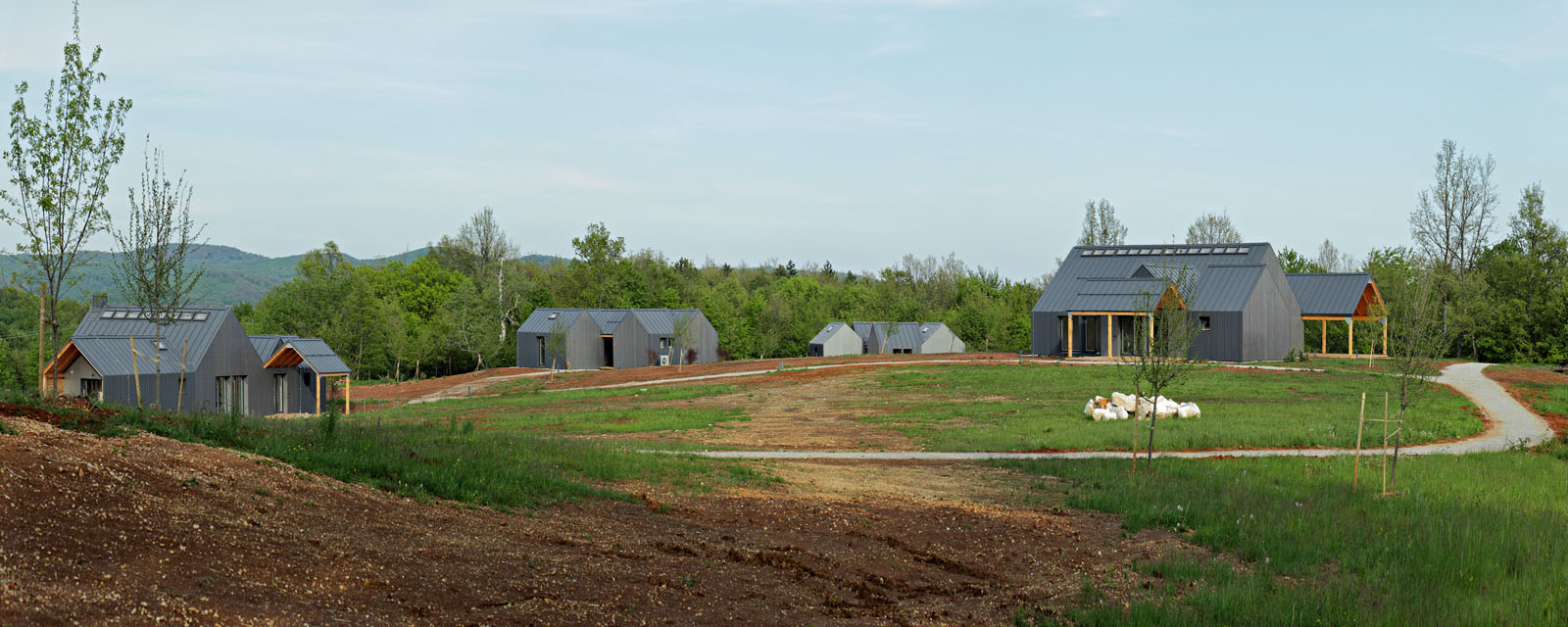
A collection of multi-purpose rural buildings, Homestead and Meditation Centre on Hartovski vrh was commissioned and designed for use by the Buddhist Center Zagreb. Their aim was to relocate activities such as chan, yoga, meditation, healthy living and teaching to a peaceful retreat outside of the city. Architects Branimir Rajčić and Mariela Žinić began the project in 2015, with the completed site arriving in 2019. Modern building materials are used, but not so the striking collection seems out of place within a partially agricultural setting. The set of buildings includes a residential dwelling and a larger hall for meetings and activities, both of which use large windows to allow the light and nature to flood in. © Robert Leš
© Robert Leš
Square of Traditional Crafts, Varaždin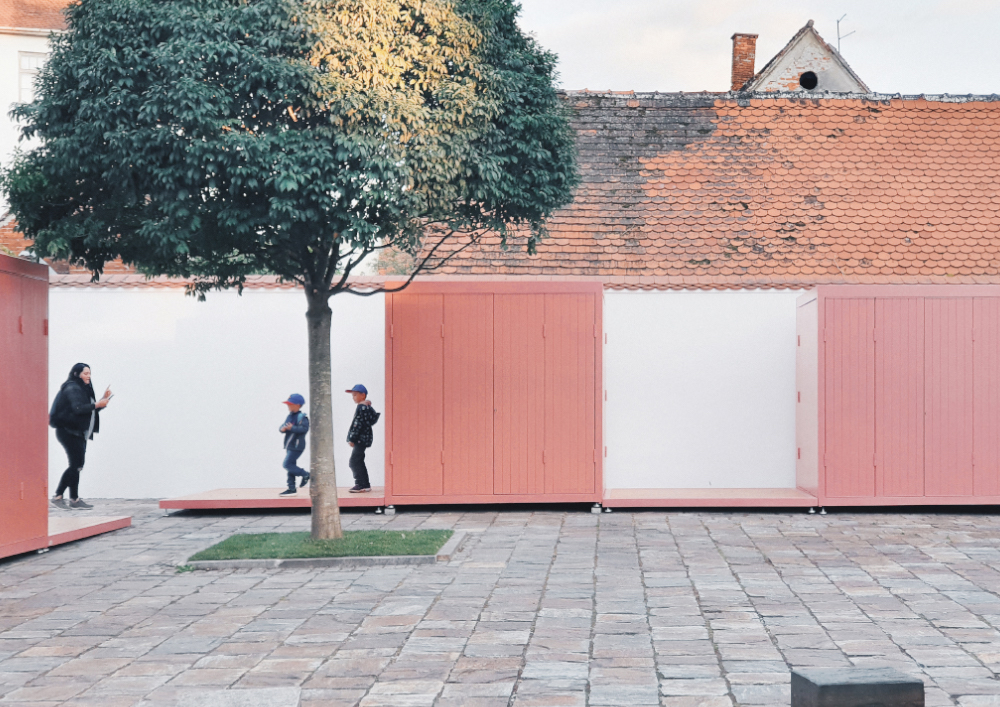
A tricky task was given to architects Studio Konntra – how to enliven and modernise a traditional old square in the centre of one of Europe's best-preserved Baroque Old Towns. They did this by constructing transportable kiosks to house small outlets for local artists and craftsmen that cater to visiting tourists who come to the square. When occupied during the day, the plain wooden interiors allows the crafts to take centre stage. But, after closing time, the outsides of the wooden doors are brightly coloured and adorned with paintings, a welcoming environment for residents to use at night.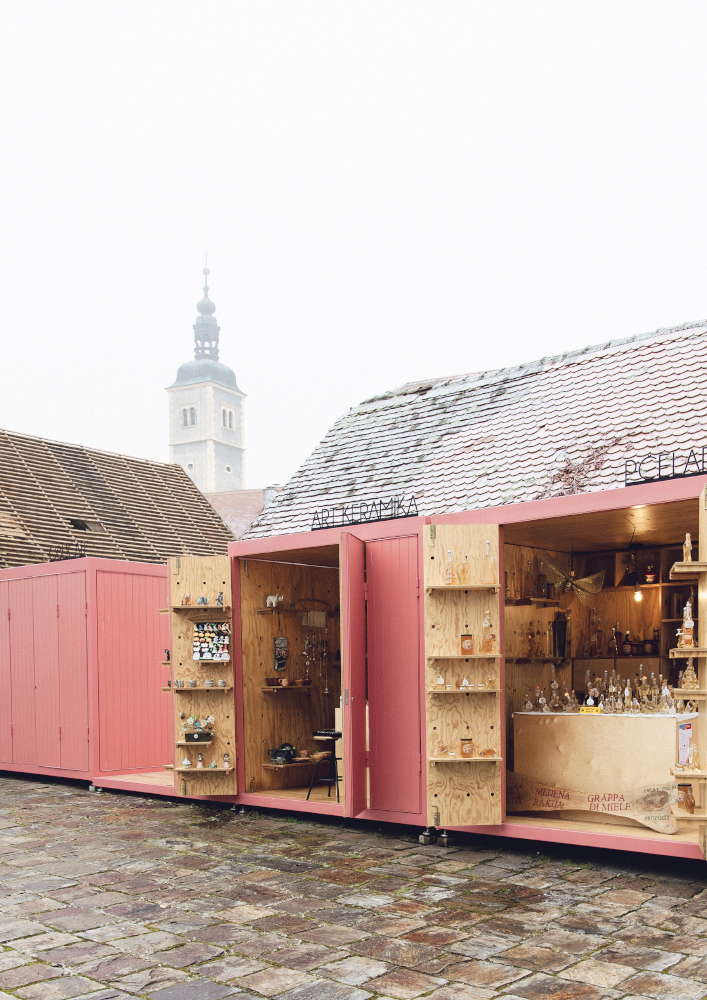 © Studio Konntra
© Studio Konntra
HNL Round 19 Recap: Hajduk Tops Istra, Osijek Wins 3:0
February 4, 2021 - The 19th round of the Croatian First League was held mid-week, on February 2 and 3, 2021. In this round, Hajduk tops Istra, and Osijek records a 3:0 win against Slaven Belupo.
Osijek v. Slaven Belupo (3:0)
Osijek and Belupo opened the 19th round at City Garden Stadium on Tuesday, February 2, 2021.
Brlek opened the scoring spree for Osijek with a goal just before the whistle blew for halftime (45+3'). A quick goal to start the second half by Zaper made it 2:0 in the 52nd minute, and 3:0 in the 55th minute thanks to Bohar.
Osijek is currently in 2nd place with 42 points, while Belupo is in 6th place with 20.
Dinamo v. Lokomotiva (2:0)
Dinamo and Lokomotiva met for the Zagreb derby on Tuesday, February 2, 2021, at Masksimir Stadium.
Gavranovic scored an early goal for Dinamo in the 9th minute for the 1:0 lead, which was the score at the half. Atiemwen increased Dinamo's lead to 2:0 in the 64th minute, which was the final result.
Dinamo is currently in 1st place with 42 points, while Lokomotiva is in 9th with 15.
Varazdin v. Gorica (2:1)
Varazdin and Gorica met in Varazdin on Wednesday, February 3, 2021.
While Gorica had the lead going into the first half thanks to a goal by Lovric (0:1), Obregon equalized for Varazdin in the 76th minute, and in the 90th minute, Boban gave Varazdin the lead and ultimately the 2:1 win.
Varazdin is currently in 8th place with 18 points, while Gorica is in 3rd with 33.
Rijeka v. Sibenik (2:2)
Rijeka and Sibenik met at Rujevica Stadium on Wednesday, February 3, 2021.
Sibenik shocked Rijeka with two goals in the 27th and 32nd minutes by Sahiti and Juric. Pavicic scored for Rijeka in the 35th to make it 1:2.
It was until the final minutes of the match when VAR ultimately ruled in Rijeka's favor, and after an 11-minute ordeal, Rijeka was awarded a penalty, which Andrijasevic scored for 2:2 (90+10').
Rijeka is currently in 4th place with 27 points, while Sibenik is in 7th with 20.
Hajduk v. Istra 1961 (1:0)
Hajduk and Istra closed out the 19th round at Poljud Stadium on Wednesday, February 3, 2021.
The only goal of the game came in the 16th minute when Nayir scored for Hajduk. The same player, unfortunately, missed a penalty 10 minutes later to increase Hajduk's lead.
Hajduk is currently in 5th place with 23 points, while Istra is in the last place with 13.
You can see the full HNL table HERE.
To read more about sport in Croatia, follow TCN’s dedicated page.
.
Ludbreg Winemakers' Wines Thrive Due to God-Given Microclimate
January 23, 2021 – The feast of St Vincent's Day, Vincekovo, could not be celebrated this year due to the epidemiological situation, but Ludbreg winemakers continue to focus on their wine production. Thanks to the very favorable climate, the Ludbreg area is suitable for planting vineyards, and local winemakers hope to soon get their well-deserved place on the Croatia's wine list.
Vincekovo, which was celebrated yesterday, January 22, in the Ludbreg area, used to be celebrated in Globočec when the plantations were blessed. The main event was a traditional and unique exhibition of young wines from the Ludbreg and surrounding vineyards, which was canceled this year due to strict epidemiological measures and a challenging situation.
It is an additional blow for all caterers who suffered the most in the corona crisis and wine producers. Local winemakers and winegrowers will wait for some better times to meet and rejoice with friends.
Sanja and Tomislav Stručić, top winemakers from Ludbreg, who met with TCN in Ludbreg last year, told their business story for the Epodravina.hr portal.
Family vineyard three kilometers from the center of the world
"We were pleased by the announcement that we could reopen our doors in February, but if we won't open until Easter, as announced, the season is questionable. We are very affected," says winemaker Sanja Stručić.
However, despite the pandemic, wine lovers are not resting. Caring for the vineyards is a year-round work, essential for producing good wine. The season begins now when the first pruning is done and lasts until the harvest.
"Last year, we estimated that, given the situation with the coronavirus, we would have stocks of wine. Therefore, we reduced the grape yield during pruning in the spring. We left grapes for sparkling wine and wines to age. We want to produce quality, not quantity, that is, high-quality wines," says the Stručić family.
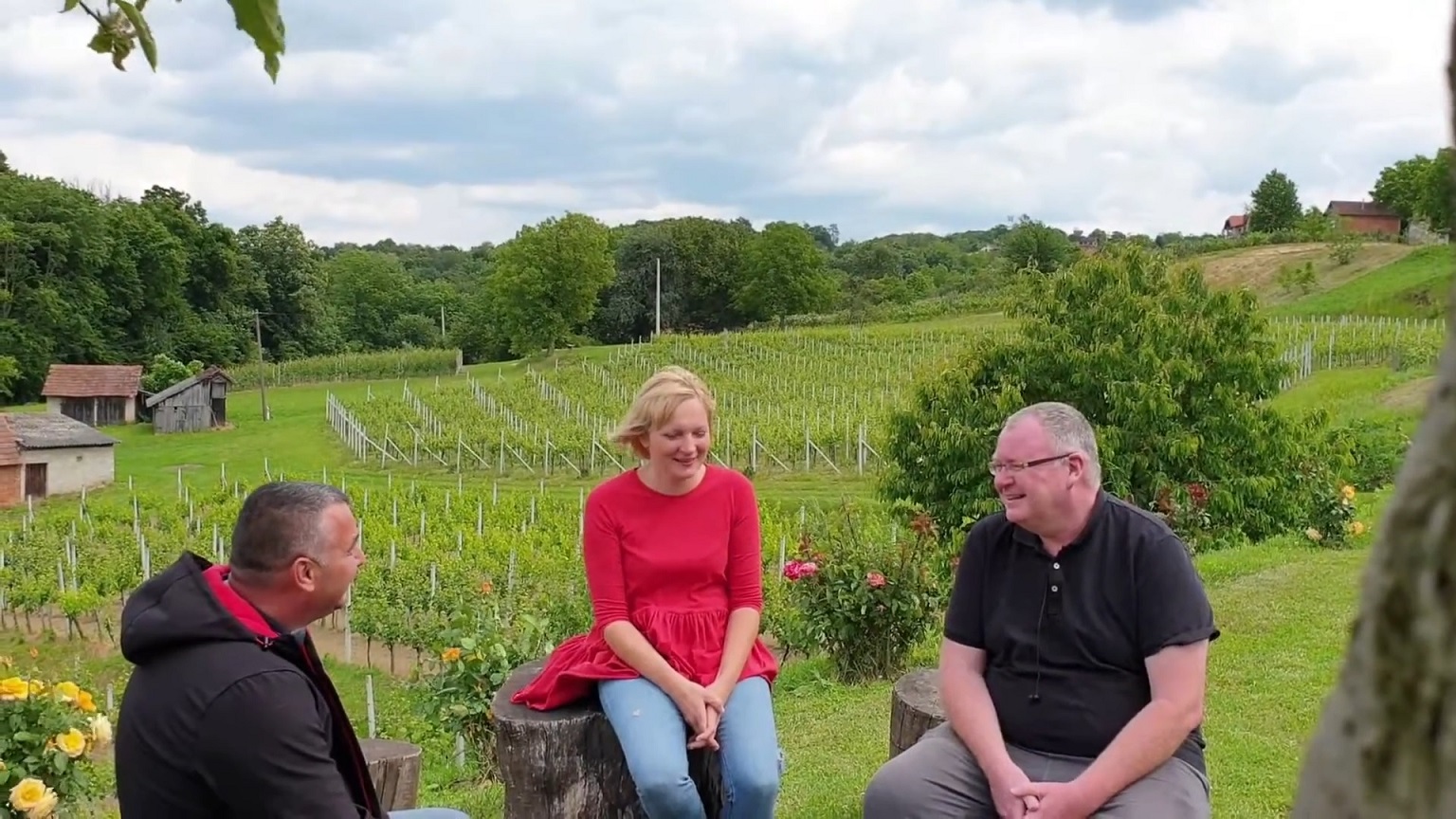
Sanja and Tomislav Stručić with Paul Bradbury in 2020, Total Croatia News
Their beautiful wine-growing hills, clean air, excellent wine, and hospitality evoke the love of land and viticulture that began in 1984 with a family vineyard just three kilometers from the center of the world. Sanja's father, Dragutin Crnković, once planted the first vineyard there, passed on his love of viticulture to his daughter, and introduced her to the wine business.
Emphasis is on the premium line of nature wines
Sanja's husband, Tomislav, also fell in love with winemaking and viticulture. In 2000 they founded the Winery, and in 2017 they produced the first sparkling wine in the region. They are the new wine style leaders in Varaždin County, and today they create top and quality wines.
Stručić Winery has become one of the most famous and successful and began more severe production in 2002. The emphasis is on the premium line of wines represented by nature wines. The premium line consists of carefully selected bunches hand-picked from selected vines. Sanja showed her love, passion, and care for each of these grapes before they become wine.
"Only ripe grapes are picked from the petiole by hand, clean and healthy. Fermentation on own yeasts and grapes, without the addition of selected yeasts, produces natural wines. This top line comes in different bottles and has different labels. We have been making it in small batches, approximately 750 bottles, for four years now, every year with a new vintage," says Sanja.
Back in 2016, Stručić family even produced a special edition of Sara Kolak Chardonnay to celebrate the local Olympic javelin gold-medal winner.
Journalists who encourage stories about gastronomy, tourism, and hedonism are also responsible for the turn in wine production. The Stručić family decided to take advantage of the microclimate and their plantations' position, which enable them to produce excellent raw materials for the production of different wine styles.
"We researched and realized that our region is a microclimatic God-given. While visiting various wine fairs and festivals, we realized we want to make different wines. The exhibitions were an incentive for us to expand our knowledge to be as good as possible. We also visited wineries in Italy to get a better insight into their viticulture and winemaking that is at a high level, and to apply experiences and some wine secrets in our vineyard and cellar," says Sanja on how they started producing sparkling wine and natural wine.
Produced the first sparkling wine in the region
The family vineyard initially had 3,500 vines and was later expanded with new plantations. Today, they cultivate three and a half hectares of land with 14,000 vines. It consists of plots named after the youngest members: Lucija, Luka, and Petra, and the newest plantation was named after their niece Katarina. The plots are registered by varieties and years of planting. The rulers of their vineyard are Graševina, Chardonnay, Rhine Riesling, Sauvignon, Portuguese and Yellow Muscat.
"We produce Graševina, Chardonnay, Sauvignon, Rhine Riesling, and mixed wines. Poštenjak is a blend – a mixture of Graševina, Chardonnay, and Pinot Gris. We make fruit wines and liqueurs, and sparkling wine. We produce about 25,000 bottles a year," says Tomislav.
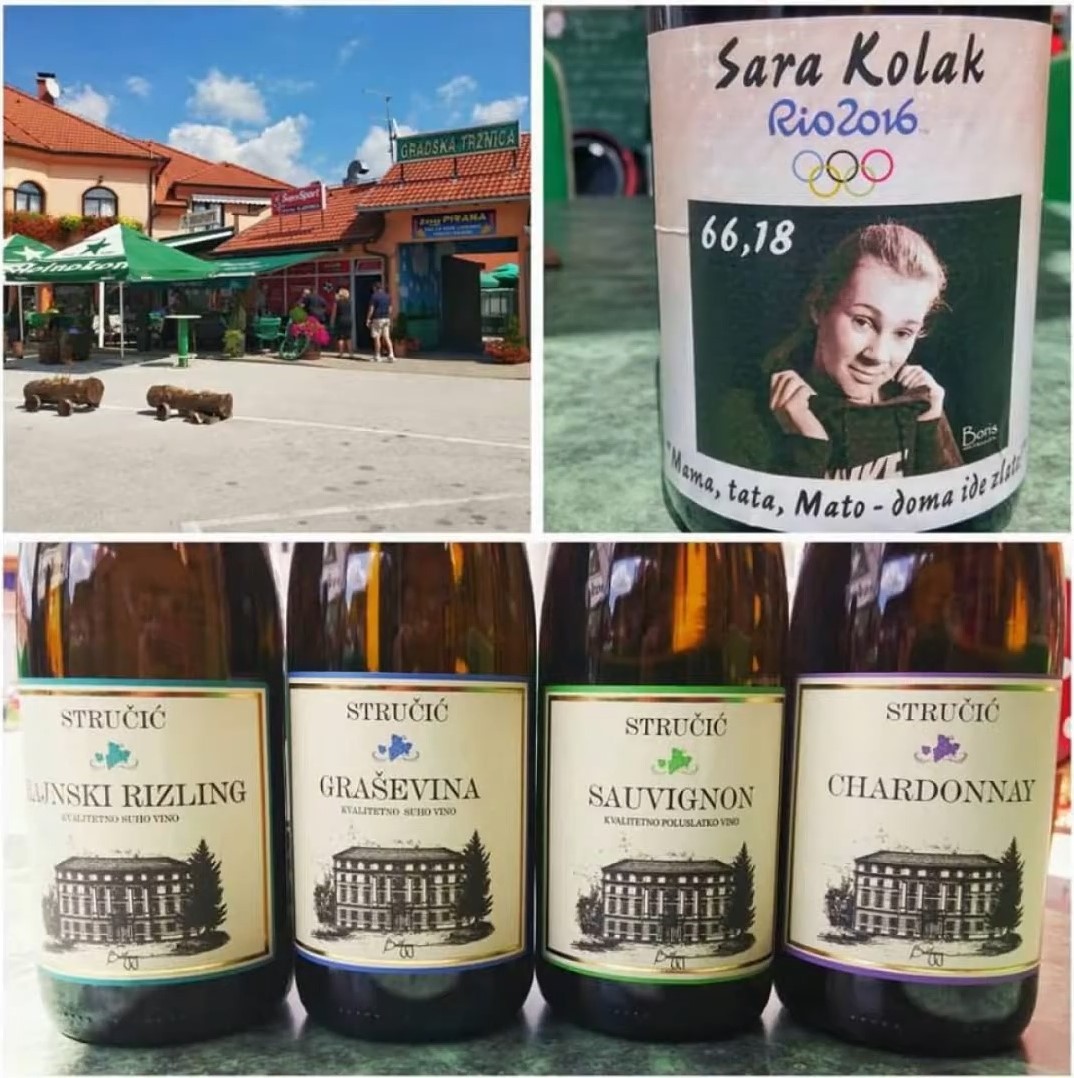
The opening of the Ludbreg Wine Road about ten years ago encouraged a stronger development of their winery. Thus, in 2017, Vinarija Stručić produced the first sparkling wine from the Ludbreg vineyards, which has the label "blanc de blancs" (namely "white from white"), which means that only white grapes were used in its production, that is, Chardonnay.
"After top quality wines, every winemaker wants to produce sparkling wine. It is the crown of your work, as if, for example, you have won the World Cup. The production of sparkling wine was our desire for a step higher. And now, three years ago, we are doing batch after batch," Sanja points out.
The Croatian Wine Institute, which evaluates and issues a quality certificate, rated their sparkling wine as top quality. And there is only five percent of top wines in Croatia, so they expanded their production in 2018 with rose sparkling wine from the Portuguese. It is a unique rarity in Croatia, produced by only one other winemaker on Plješivica.
Microclimatic conditions with a continental climate favor the quality ripening of grapes, so the Podravina and Zagorje regions are God-given for sparkling wine production. The Ludbreg vineyards' climate is ideal for producing light wines with little alcohol, sparkling wine, and wines of late harvests.
Decanter quality certification
Stručić Winery sells its products throughout Croatia. In Ludbreg, visitors can taste their wines in the Bonaparte coffee bar, which they own, as well as the Amalia catering facilities, Pivnica Mejaši, and Hotel Crnković.

"Rhine Riesling is mostly associated with the name of our winery. It is our flagship and our most sought after wine on the market. Then follow Graševina, Chardonnay, Portuguese, Sauvignon… Premium wine lines, sparkling wines, aged, and nature wines are distributed to the Adriatic coast," says Tomislav.
The secret behind the Sučić Winerys's success, Sanja points out, is harmony, great love, patience, a lot of sacrifices, and constant investments. Proof of quality arrived last August when the Stručić Winery won a bronze medal for Chardonnay and recommendations for Rhine Riesling and Graševina at the most influential wine evaluation – the Decanter World Wine Awards 2020 in London.
"It is a confirmation that we make quality wine. With these recognitions, we have increased visibility," says Tomislav with satisfaction.
Ludbreg vineyards on the wine list of Croatia
For wines to achieve top results, a lot of education, work, and knowledge is needed, so the Stručić family cooperates with the leading Croatian sommelier and Decanter judge Siniša Lasan. With Varaždin County's cooperation, Siniša visited several wineries and tasted wines, discussed problems, and gave his view of the current situation in winemaking in the county.
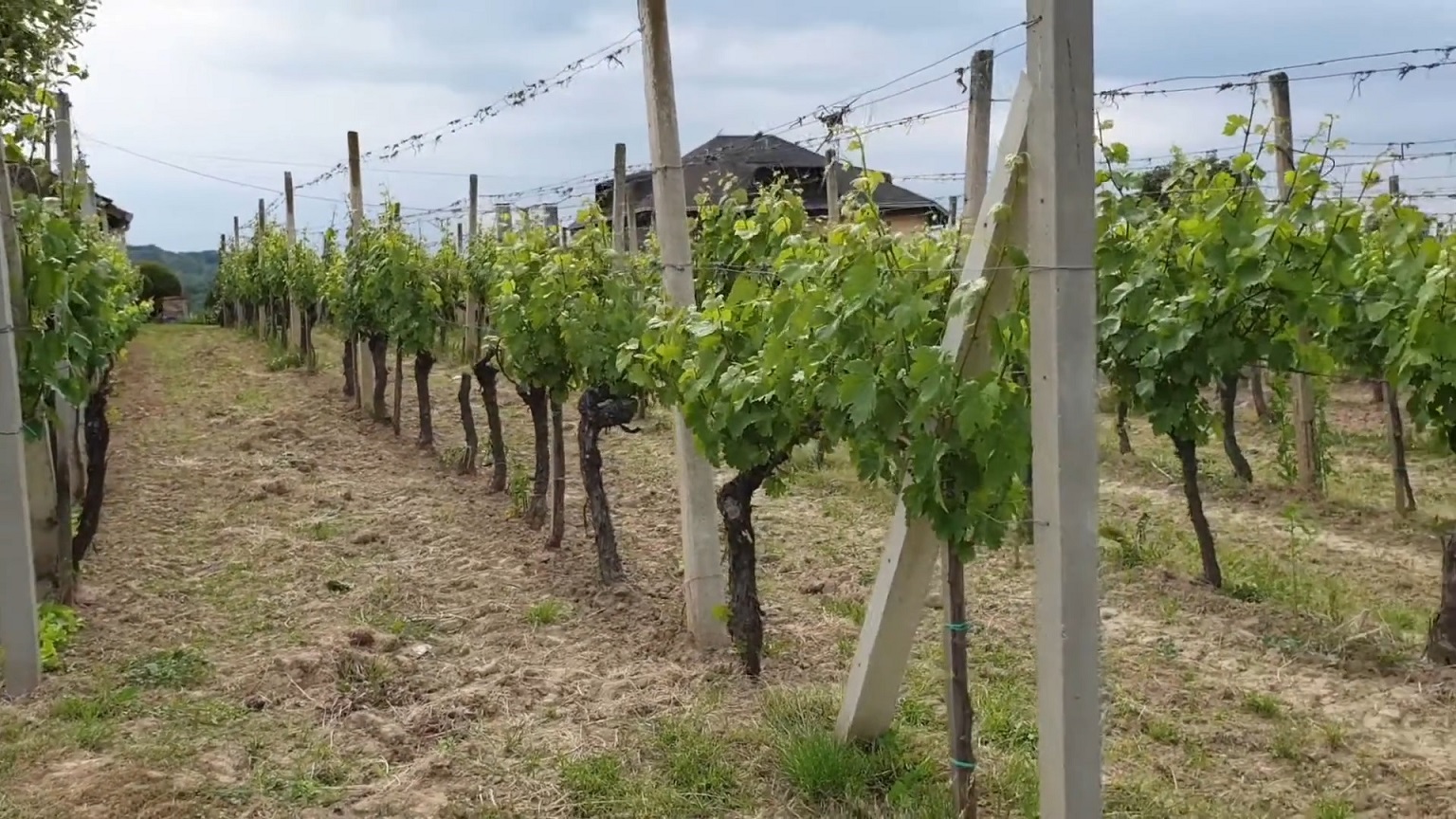
Continental tourism is in the beginning. Tourism Ministry began to give it importance and encourage it only a few years ago.
"The Ludbreg and Varaždin vineyards are neglected. They are not marked on Croatia's wine list, and our winemakers are very hardworking but self-effacing. A dozen of us from all over the county will have to sit down, compare wines, listen to the profession to style them if necessary so that we stand out together with quality. I believe that we will soon mark our vineyards on the wine list, which would raise the price, and we could sell our wines more easily on the doorstep," Sanja is optimistic.
"Viticulture is a demanding activity that requires a lot of attention because wine is alive and should be continuously monitored. Without love for the vineyard and wine, there is no progress, "the Stručić couple agrees.
However, the biggest reward in their work is that the interest in winemaking is shown by their 17-year-old son Luka. He wants to enroll at the Faculty of Agriculture and become a wine expert, oenologist. Thus, when the time comes, to the family's satisfaction, the winery will be taken over by the third generation, which will cultivate, enrich, and further create new top-notch wines.
To read more about Ludbreg, follow our dedicated page.
Google Data Centre California Covered by 120,000 Varazdin Solar Panels
January 16, 2021 – Just as the white stone of Croatia was once exported globally to help build some of our most iconic buildings, Varazdin solar panels will be used atop the domes of one of the contemporary world's biggest businesses - the Google Data Centre in California
From the statues of Ivan Meštrović to the white stone of Dalmatian mines (like the famous one that still works on the island of Brac), Croatia has a long history of exports within the fields of aesthetics and architecture. A whole new eco-friendly tag is now being added to that reputation as one Croatian company prepares to send 120,000 Varazdin solar panels to cover Google's Data Centre in California. The purchase is part of the company's drive towards relying on carbon-free energy solutions.
The 120,000 Varazdin solar panels will be provided by Croatian company Solvis, who have held a contract with the California-based global search engine for quite some time. The 120,000 Varazdin solar panels will cover newly constructed domes at their Data Collection Centre in California, just a short distance from the company's global headquarters in Silicon Valley.
The contract for the 120,000 Varazdin solar panels and continuing co-operation with Solvis is, according to a recent article in Croatia's Jutarnji List, worth in excess of 10 million Euros.
Search engine Google is currently the most popular of its kind. Although it is based in California in the United States of America, where the 120,000 solar panels from Varazdin will be situated, it has properties all over the world. The purchase of the 120,000 solar panels from Varazdin is part of a drive for Google to equip all its buildings in the world with solar panels. Therefore, if the business between Google and the Varazdin company is successful, it could lead to more orders and an extended collaboration with the northern Croatia company.
Varazdin Old Town Nominated For Croatia's Second European Heritage Label
January 11, 2021 – Comparable to UNESCO's World Heritage List, the European Heritage Label is given to sites that have played a significant in the history, culture and values of Europe. If successful, Varazdin Old Town will be only the second site in Croatia to receive the classification
They say that Northern Croatia has more castles, fortresses and stately homes than any other region in the country. And they are probably right. Not that the names and locations of all are widely known either in the country, and certainly not outside. Truth be told, some of the structures included on Northern Croatia's list of important buildings have lain derelict for centuries. In others, the decline has been more recent. The best way to preserve such buildings seems to come from reimagining them for contemporary use, rather than simply preserving them in aspic or amber.
That is something that Varazdin Old Town does extremely well. All of Northern Croatia's famous castles do this well - Čakovec castle, Trakošćan, Veliki Tabor and Gornja Stubica. It's the reason they are famous. By opening up their doors as museums and event spaces, they attract hundreds of thousands of visitors each year and they get to tell their stories. And the story of Varazdin Old Town makes it perfect for the European Heritage Label.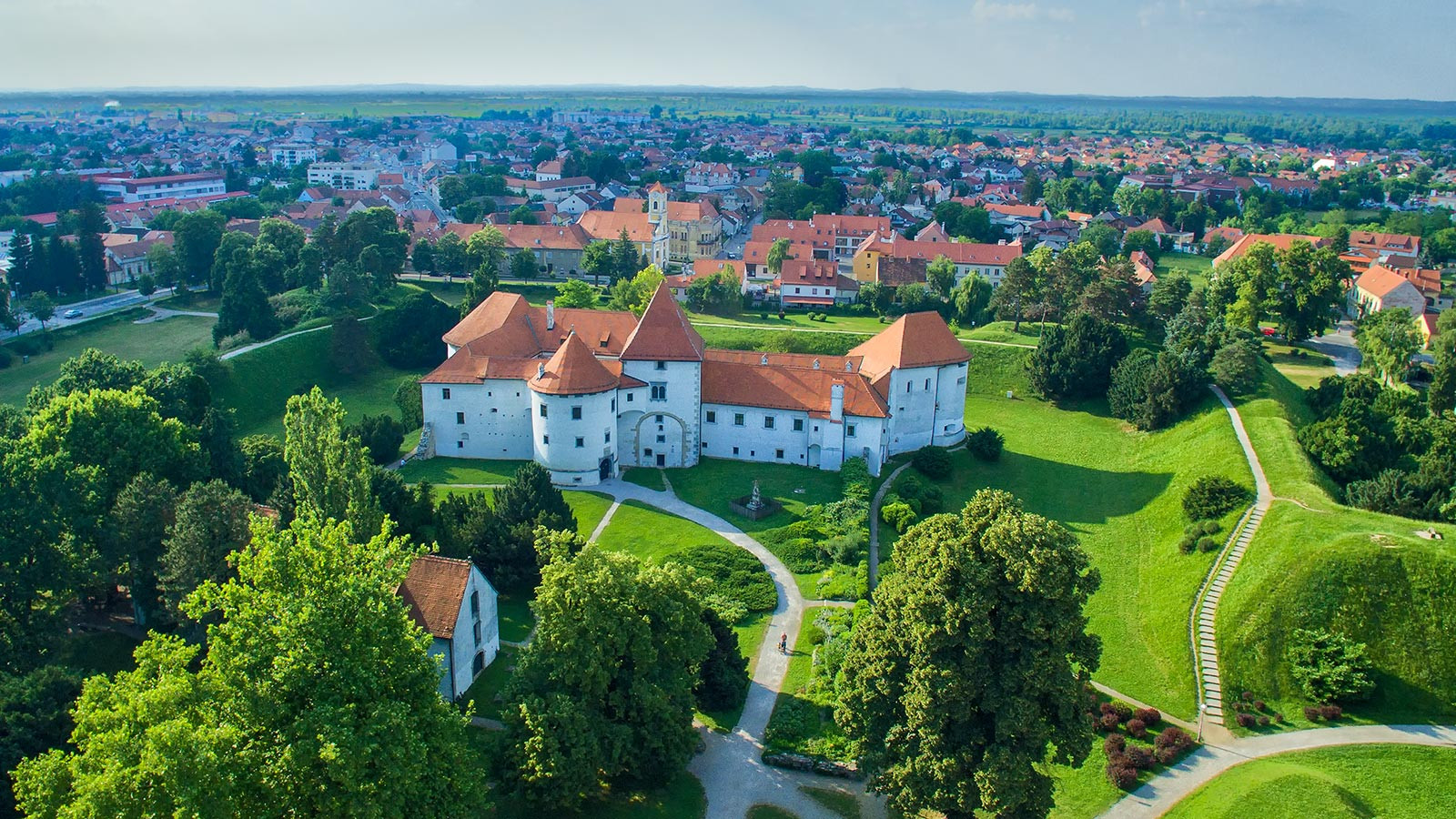 © Ivo Biočina / Croatia National Tourist Board
© Ivo Biočina / Croatia National Tourist Board
Varazdin Old Town is today inhabited by the Varaždin City Museum. They give guided tours around the fortress that was once the full extent of Varazdin Old Town. This city museum is the best way to learn about Varazdin's extraordinary buildings, culture and history. The museum has undertaken this role, and that of preserving items from Varazdin's past, since 1925. It has four permanent exhibitions and six major departments – Archaeology, History, Cultural History, Ethnographical, Entomology and the Gallery of Old and Contemporary Masters, some of which are inside the Old Town fortress itself.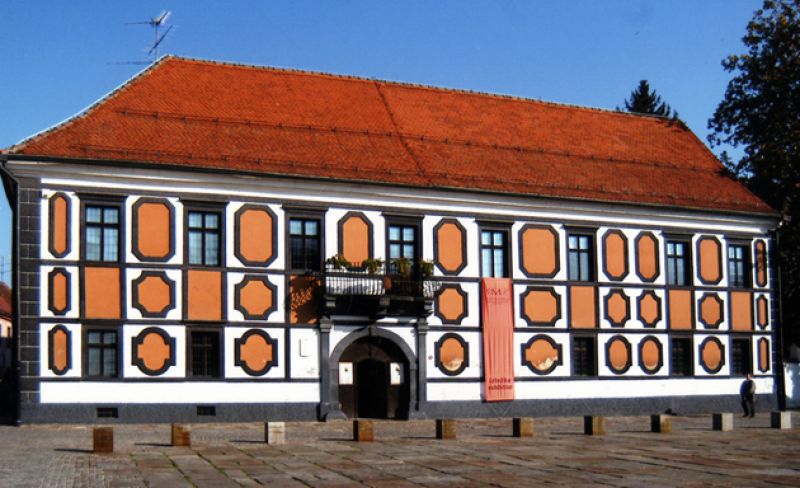 The Gallery of Old and New Masters of Varaždin City Museum © City of Varazdin Tourist Board
The Gallery of Old and New Masters of Varaždin City Museum © City of Varazdin Tourist Board
The Old Town fortress itself is medieval in origin, its construction having begun in the 14th century. Its Gothic towers were added a century later and the collection of buildings was remodelled and added to right up to the 19th century, in response to its inhabitants and its purpose.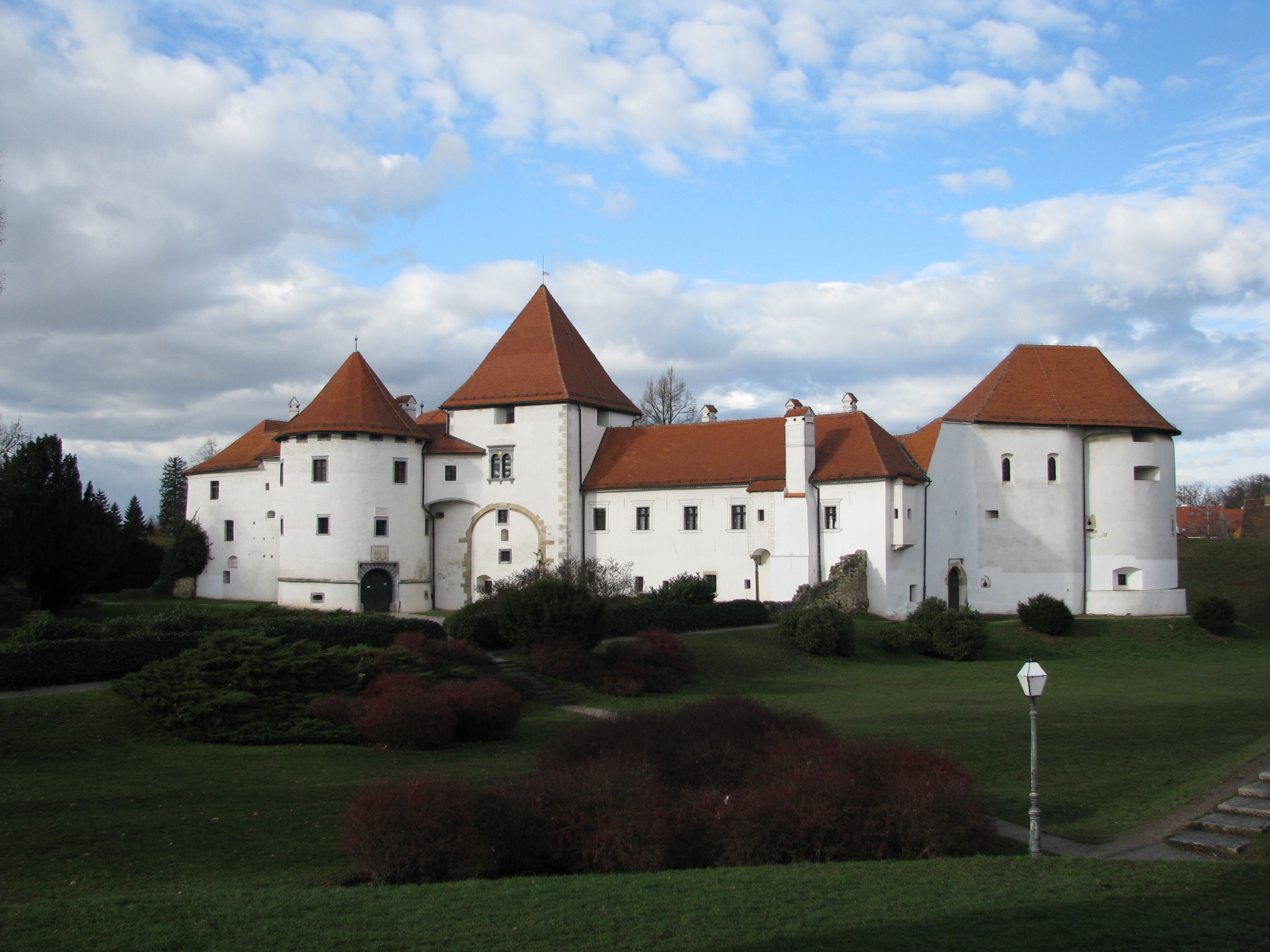 © Ex13
© Ex13
For defence against the Ottomans in the 16th century, it was reconstructed as a Renaissance fortress – high earthen walls with bastions were added, and a double moat. During the past, many noble families have lived here - the Counts of Celje, John Ungnada, George of Brandenburg and Croatian Ban Thomas Erdödyja and his successors. Indeed, Varazdin was once the capital city of Croatia, ruled from these very buildings. In its changing use, architecture and occupancy lies the story of not only the development of Croatia but that too of Europe and it is this that makes Varazdin Old Town eligible for the European Heritage Label.
The European Heritage Label is awarded to sites that bring to life the European narrative and the history behind it. The European Heritage label is currently awarded only every two years. So far, the only site in Croatia to receive the European Cultural Heritage Label from the European Commission is the Neanderthal Museum in Krapina. Its label was awarded in 2015.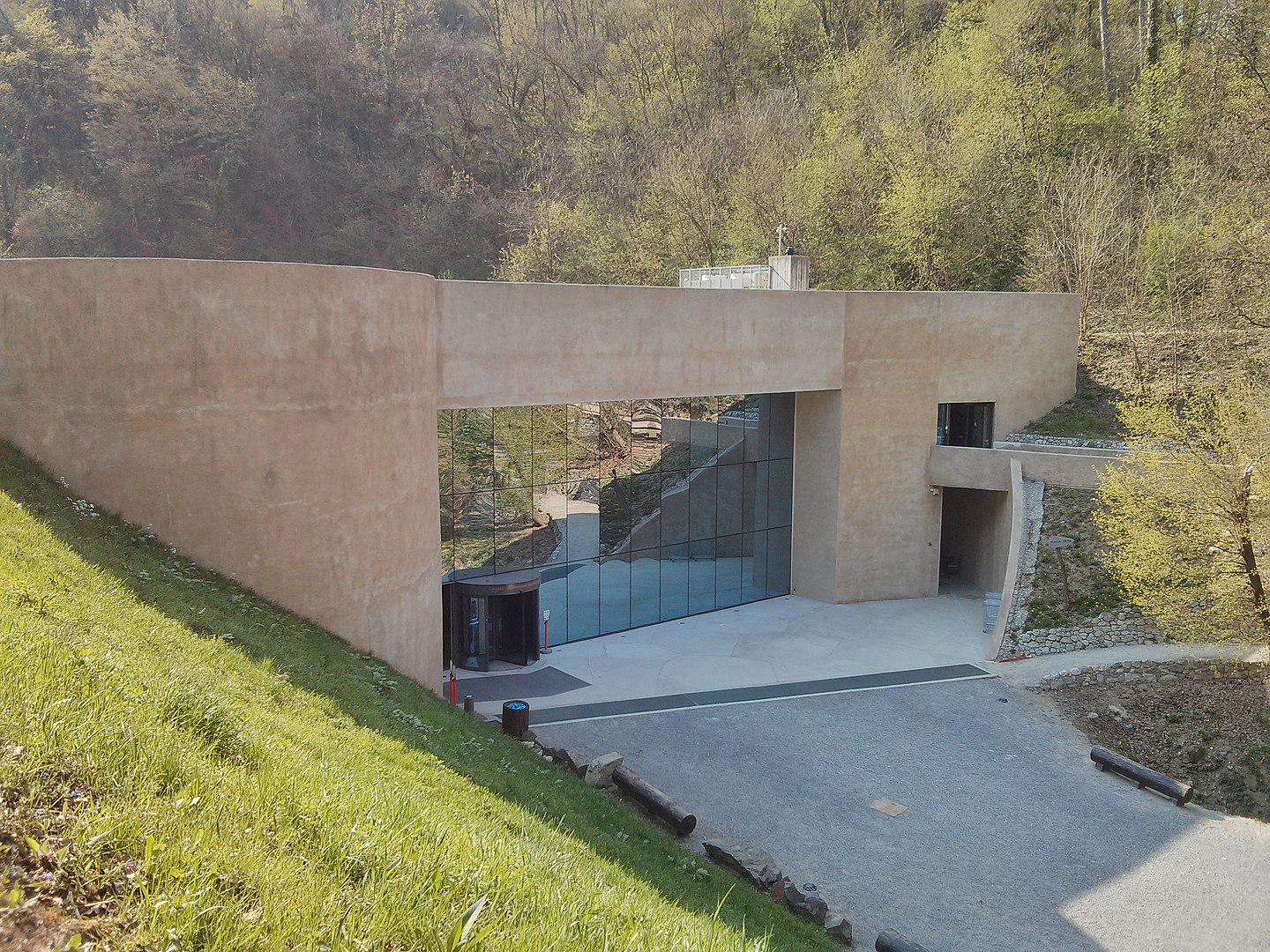 The Neanderthal Museum in Krapina, also in Northern Croatia. It received its European Heritage Label in 2015 © Zeljko Filipin
The Neanderthal Museum in Krapina, also in Northern Croatia. It received its European Heritage Label in 2015 © Zeljko Filipin
Strongest Croatian Brands Survived and Succeeded After Independence
January 4, 2020 – A map showing production across the former Yugoslavia details the sustained prosperity of many Croatian favourites as some of the strongest Croatian brands are shown not only to have survived but have succeeded following independence
Media across Croatia, Bosnia and Serbia have surprised younger readers and reminded older readers with the publication of a map detailing production in the former Yugoslavia. While this trip down memory lane has caused a range of reactions across the countries of the former republic, looking at the map from a purely Croatian perspective gives some enlightening information. Namely, many of the strongest Croatian brands visible on the map are recognisable today. Some of the strongest Croatian brands not only survived independence but have since grown.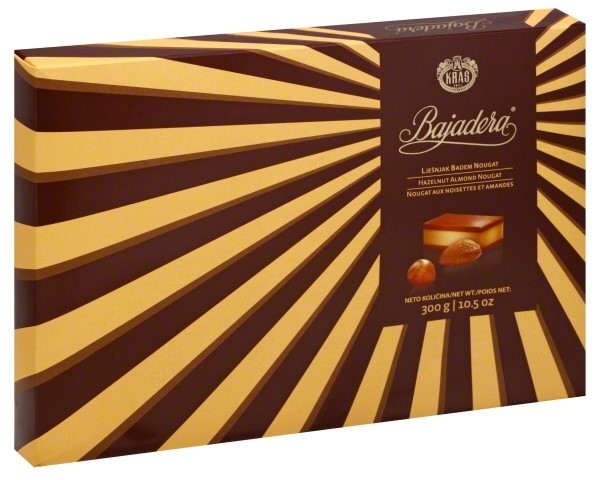
Bajadera - one of the most popular products made by Zagreb-based chocolate and confectionery manufacturers Kraš
Zagreb-based chocolate and confectionery manufacturers Kraš, Požega-based confectionery and drinks manufacturers Zvečevo, oil company INA, Koprivnica-based food company Podravka and Koprivnica-based pharmaceuticals company Belupo, vitamin drink Cedevita, Varaždin-based food company Vindija, Vukovar shoemakers Borovo, Varaždin clothes designers and manufacturers Varteks and multi-use condiment Vegeta are just some of the strongest Croatian brands that are present on the map. You are still likely to see these brand names on many Croatian high streets. Some have succeeded in reaching further into international markets since Croatian independence.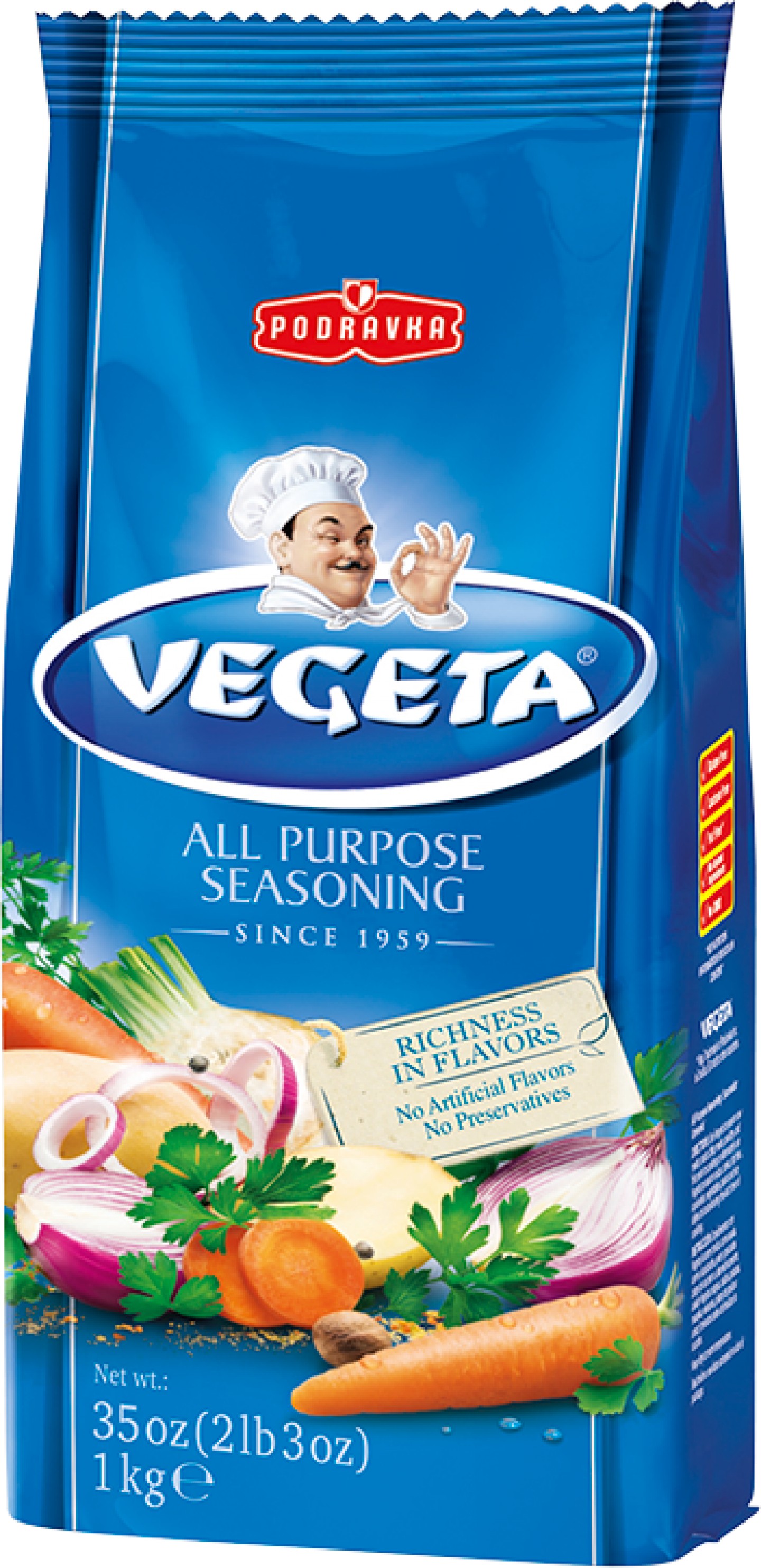 Croatian-made condiment Vegeta is sold all over the world
Croatian-made condiment Vegeta is sold all over the world
Of course, not every brand visible on the map of Yugoslavia production has fared so well. In their coverage of the map, Ri.portal reminds that “Some of the Yugoslav products were used by literally the whole world - ships, cars, planes, trucks, weapons and even computers were produced... However, many of these companies no longer exist or are bankrupt.”
In their coverage of the map, Bosnian website Klix reminds that Croatian shipyards Uljanik in Pula and 3 Maj in Rijeka were at world level and produced large ships for customers from all over the world. Split-based shipyard Brodosplit, which can also be seen on the map, survives to this day.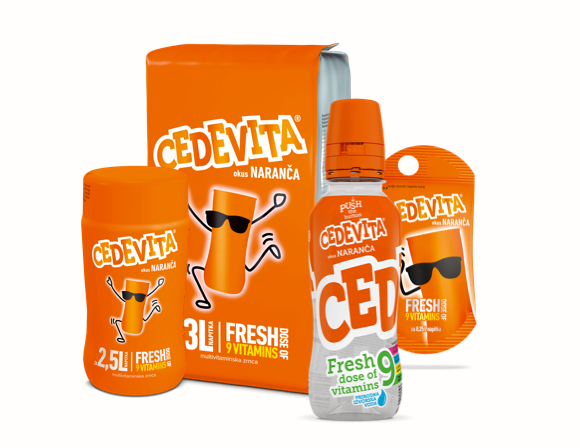
Croatian vitamin drink Cedevita comes in a range of flavours
Ri.portal goes on to remember that Yugoslavia was one of only five countries in Europe at the time that manufactured its own computers. “Probably the most famous is the Galaxy, while the first computer produced was the CER-10,” they say. One of the Yugoslav computer makers on the map, popular in the late 1970s, was Digitron, based in Buje in Istria.
Sadly, not all of the strongest Croatian brands have made it until today. Famous tractor and agriculture equipment manufacturer Tomo Vinković of Bjelovar is no longer in production. Their famously-reliable machines are much in-demand on the secondhand market. Two new tractor manufacturers, Hittner doo and the Prima tractor factory still make tractors in Bjelovar.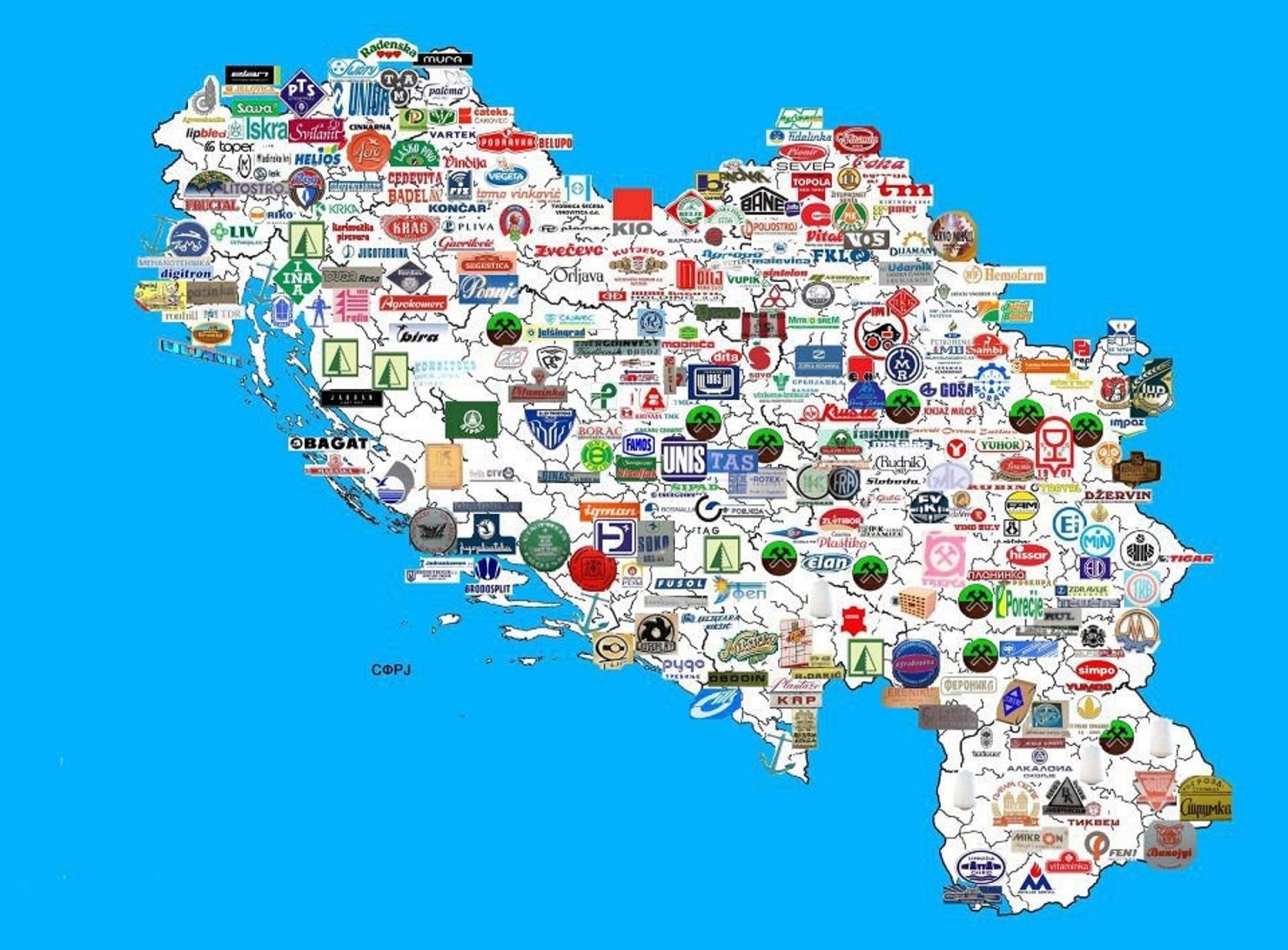
Holiday Homes with a Story: Branding Rural Accommodation in Varazdin County
November 11, 2020 - "Holiday homes with a story," a project that brands rural accommodation in Varazdin County, continues to expand.
HRTurizam writes that after the Varazdin City Market initiated the delivery of groceries to the homes of Varazdin citizens, now groceries from the market can be directly delivered to all guests thanks to "Holiday homes with a story."
The first step of connecting agricultural producers in the Varazdin region with holiday homes was realized through the so-called "Varaždinske kištrice" (see photo below) which each group of guests receives as a welcome gift and aims to present indigenous products of Varazdin County.
Namely, the Varazdin County Tourist Board has provided this for free for all "Holiday homes with a story" members, and it currently contains Varazdin pumpkin oil, gingerbread, honey, buckwheat flour mlinci, lavender and eco-cosmetics, and tourist brochures with all relevant information.
The availability of fresh food, without leaving your holiday home has been recognized as an opportunity to better connect small farmers with tourism and involve the wider local community in developing and raising the quality of the project.
Fresh food delivery can be ordered from Monday to Saturday. The completed order leaflet, which can be found in every participating holiday home, must be photographed and sent to the e-mail address: This email address is being protected from spambots. You need JavaScript enabled to view it..
The Varazdin market has a Certified Peasant Market status, which guarantees sales directly from producers and the ecological origin of products. The price of delivery depends on the distance of the holiday home, and the price list of groceries can be checked HERE.
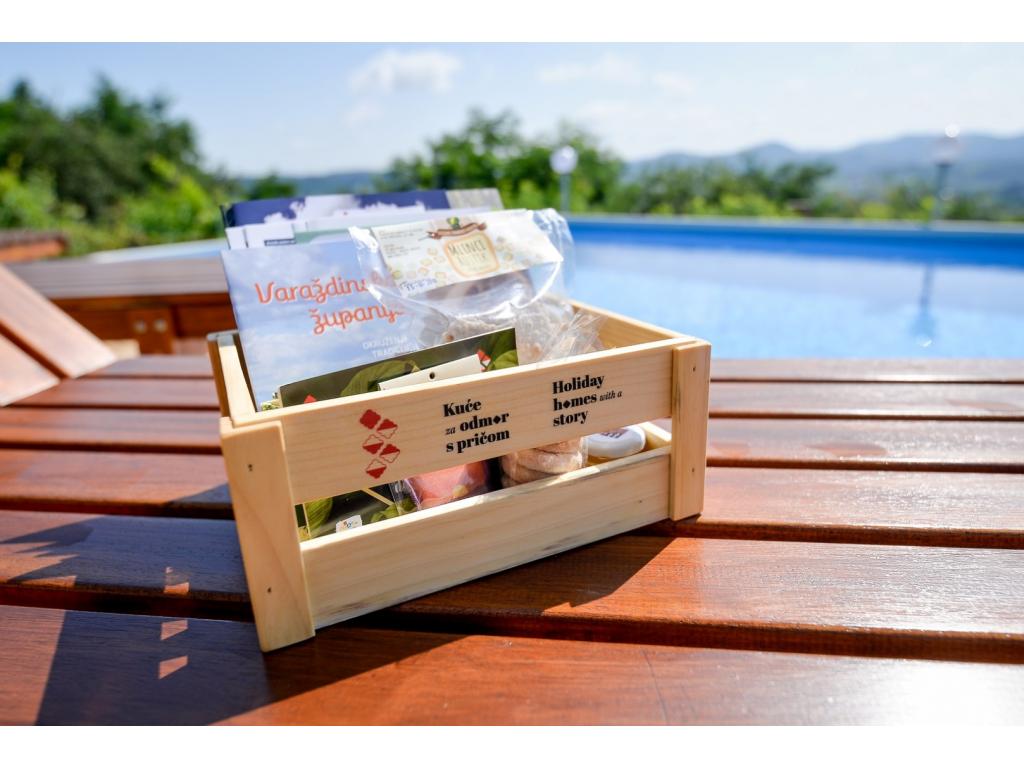
TZ Varazdin County
This is certainly a step further in involving small farmers in tourism and responding to the needs of modern guests who believe that “eating local, healthy, and homemade” on vacation or traveling is increasingly important.
Furthermore, Varazdin pumpkin seed oil is the first in Croatia to protect its name and geographical origin. The fact that Varazdin pumpkin seed oil won two gold medals at the prestigious world competition Monde Selection in Brussels in May this year confirms that it is a top product.
Varazdin County has seven products under one of the forms of protection in the European Union and/or in Croatia. In addition to pumpkin oil, these products include Varazdin cabbage, Zagorje turkey, Zagorje mlinci, Varaždin klipič, Zagorje struklji, and Zagorje acacia honey.
There are currently 45 holiday homes with a total of 220 beds included in this project.
According to data before the coronavirus pandemic, about 90 percent of tourists who visit "Holiday Homes with a Story" are Germans, Danes, and Scandinavians. On average, they stay a minimum of seven nights. You can find out more about the whole project and a list of all the homes with a story on the dedicated website.
For the latest travel info, bookmark our main travel info article, which is updated daily.
Read the Croatian Travel Update in your language - now available in 24 languages.
Join the Total Croatia Travel INFO Viber community.


